Sorting images
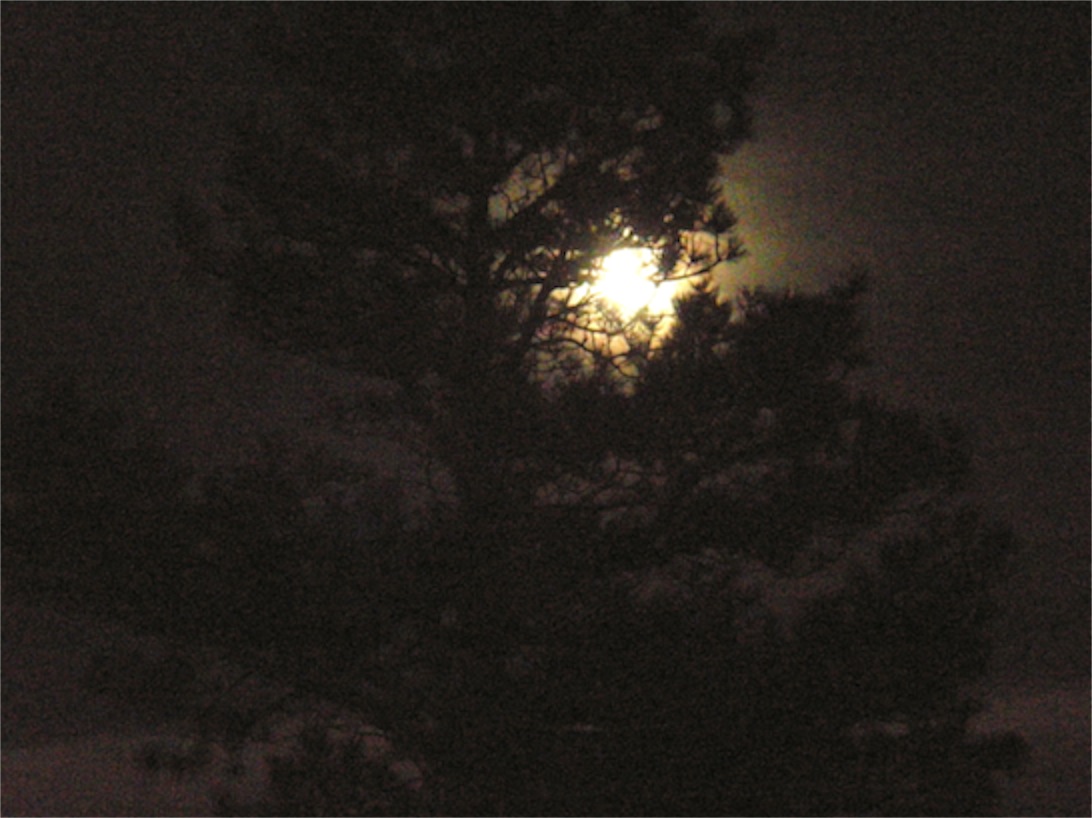
I went out on our deck after supper last night and snapped a few pictures of the moon. I don’t have a particularly fancy camera and I am not much of a photographer, really, but I enjoy photographs as a way of capturing memories. Photography has changed so much in recent years that the purpose and use of pictures is very different. Years ago, when I took a photography class from Archie Lieberman, each image was carefully selected, printed and displayed. The particular class that I took required to us to submit black and white photographs mounted on mat board. Our prints were to be a minimum of 11” x 14”. We hung our pictures around the room and then took a tour of the class’s work as if walking through a gallery. The assumption was that each image was a handcrafted work chosen for its artistic value. The pictures were expected to last.
These days photographs are sent directly from a cell phone or tablet computer to an internet social site. It is not uncommon for people to post dozens of pictures in a matter of a few minutes. Our lives are filled with images that change so often that it is almost like watching a movie. For that matter, many cell phones now can take digital video images and the resulting movies can be posted on the Internet with similar ease. I have read that on the site YouTube 48 hours of video is uploaded every minute. It is literally impossible to watch all of the video that is on the site. It may be technically impossible for one person to watch all of the videos of cats on YouTube.
As a result, our perception of photographs has changed. There was a time, near the beginning of the development of photography, when each image took hours to produce and, once produced people would study that image intently. A static image simply does not command our attention any more. The filmmaker Ken Burns discovered that when he began to incorporate historic photos into his documentary films. People won’t look at a photograph enough to perceive what they have seen. Burns developed a way of subtly making a still photograph appear to have motion. He would focus on a single detail and then gradually widen the perspective to include the entire photograph or reverse the process and start with an image of the photograph and slowly zoom into a single detail. The process is now known as the “Ken Burns Effect” and is considered to be a standard when projecting images. The effect is now available in simple presentation software.
We are so inundated by images that we don’t treasure individual images the way we once did. In the future those wanting to tell the story of our time will have so many images to sort through that many images will be lost amid the clutter.
I remember visiting the home of friends many years ago. They were very organized people and their home was always neat. It was comfortable and inviting for guests and each item was always put away. There was no clutter on kitchen countertops or tables. Even the end tables in the living room were neatly organized. Yes, the spices were arranged in alphabetical order in the spice rack. We visited these friends regularly and occasionally commented on the neatness of their house. It was a contrast with our usual level of clutter. One day when I was visiting, our friend went looking for a photograph of a recent church event. I watched with delight as she opened a drawer that was filled to the brim with unorganized images. There were many packets of photographs from the drugstore all piled in the drawer in no apparent order. In those days I was doing predominantly slide photography and my slides were all neatly stacked in boxes, with the date range of each box labeled. It was a moment of triumph to discover one area of life where I was more organized than our friends who had appeared, until that moment, to be so much more organized than we.
Of course those were the old days. These days that friend has a neat row of well-organized photo albums. We have a computer in our home with over 24,000 digital images on it. We are constantly adding to the collection on the computer by scanning slides and old photographs. The boxes of 11 x 14 black and white images along with the negatives of those photo shoots are in storage and it doesn’t appear that we will get to them anytime soon.
I may not have a drawer of printed photographs, but the image of that drawer of unorganized photographs certainly sticks in my mind as a metaphor for the way photographs are taking over my life. I find myself using more an more stock and news photographs in my daily blog simply because the Internet is easier to search than my photo files.
What I really need to do is to sort through all of those images and delete the ones that do not have lasting value. If I do not, I risk leaving a legacy to the next generation where the trash and the goodies are so intermingled that everything is discarded, including the few gems that should be preserved. It is easy to imagine someone simply never getting around to looking through all of the images.
Sorting through clutter is one of the primary tasks of people my age. Eric James called it integration and identified it as the primary developmental task of older adults. Making sense out of all of the experiences, organizing the memoir, telling the story in a meaningful way – these tasks all require deciding what to keep and what to discard.
But I find myself taking more pictures rather than sorting through the ones I have. I added 15 or 20 shots to the digital files last night. Maybe one image is worth sharing. I’ve included it in today’s blog. The rest do not need to be saved. Eric Erickson would say that I’ve gotten hung up in generativity and need to move on to integration. Perhaps he’s right. Maybe I’m just a little slow in my development.
With the mountains of things I’ve got to sort, it doesn’t appear that boredom will invade my life anytime soon.
Copyright © 2012 by Ted Huffman. I wrote this. If you want to copy it, please ask for permission. There is a contact me button at the bottom of this page. If you want to share my blog a friend, please direct your friend to my web site.
Weathering storms
The weather forecasters were right. This is a huge and dangerous storm. The count of fatalities is rising. There is plenty of danger associated with this weather system.
It appears that the replica tall ship, Bounty, has been lost at sea trying to make a run around the storm to Florida. Most of the crew has been rescued, but one crewmember is confirmed dead and the captain is missing at sea. The loss of tall ships was common in the days when they were the primary mode of ocean transportation. These days, with sophisticated weather prediction, on-board radar and other technical advances, the ships can often be moved to safety when weather threatens. It didn’t work out in this case and the ship that appeared in several movies is now lost.
Closer to home, there were six suspicious fires set along Catron Boulevard yesterday. Fire officials were able to douse the blazes quickly, but it isn’t good news to know that there is an arsonist working in our neighborhood during these tinder-dry days with too much wind for comfort.
But the story that will probably dominate our local newspaper today is a tragedy that struck Black Hills State University Sunday night. Officials have not made the formal announcement of suicide, but it is clear, even to a casual reader of the news that suicide is the cause of death. The police department is waiting for autopsy results before making a formal declaration, but a Spearfish Police investigator has said, “The scene shows us that it was not a suspicious death.”
I work with families who are struggling with the grief and impact of suicide on a regular basis. All of us who are involved in this kind of work do everything within our power to prevent suicide. I have received ASIST training and I carry cards with suicide information and the number of the suicide prevention hotline with me everywhere I go. I give cards to students and parents and anyone else who might read them. The cards I use have a summary of warning signs of suicide as well as the number of then National Suicide Prevention Hotline. I know that I have given those cards to a student from our church that is a resident of the same campus dormitory where the other student died on Sunday. From what information I can gather this was a suicide with very few or no outward signs. The student who died did not present outward signs of depression. He was outgoing, involved and seemed to be happy with his life and situation.
But he is dead. And his family and friends are caught up in the grief of a sudden and traumatic loss. The campus is suddenly aware of the fragility of human life. Kids who have never experienced the death of a loved one are suddenly in the middle of emotions that they have not previously experienced.
The Front Porch Coalition, our suicide prevention organization, has just expanded into the Northern Hills, affiliating with local Survivors of Suicide to expand our services and activities beyond the single county that has been our primary service area. A team of people from our group will be on scene at the college working with students, faculty and other community members as we begin to process and deal with this loss. We have some relatively new volunteers who will be getting way more experience way more quickly than they expected or wanted. That is the way it is when tragedy strikes a community. We pull together. We support one another.
We are aware that the scale of the tragedy to strike a relatively small university campus in the Black Hills of South Dakota is not much compared to dozens of deaths as a major storm system pounds the East Coast of our nation. Our little suicide response team is miniscule compared with the disaster response teams that are required to deal with the aftermath of Sandy. But for us it is big news.
The simple truth is that every death is an individual tragedy that is beyond compare. Every loss is personal to those who knew and loved the victim. When a monstrous storm strikes we are well aware that there are things that are beyond our control and that we can prepare, but we cannot stop the fury of a storm. It is different with a suicide. Some suicides can be prevented. Prompt treatment can provide safety for some potential victims. But intervention is an inexact science and there are plenty of deaths where no intervention was attempted because no one saw the death coming.
They can do all of the autopsies and investigations that they can muster and they cannot change the simple fact that essential information died with the victim. There are things that we will never know and information that we cannot learn.
While our sisters and brothers on the East Cost are cleaning up in the aftermath of a storm, we are trying to pick up the pieces following our own tragedy. We share the reality of grief. We can’t help but wonder about what might have been. And we are human in our need for one another and in our need to support each other in our common loss. This is not the end of the world. This is not the death of hope. It is, however, a very tough day for a lot of people. It is a day for the rest of us to roll up our sleeves and go to work to do what we can to help.
Copyright © 2012 by Ted Huffman. I wrote this. If you want to copy it, please ask for permission. There is a contact me button at the bottom of this page. If you want to share my blog a friend, please direct your friend to my web site.
Autumn
As I said, the fantasy was short-lived. Pine needles are harder to rake than leaves. And, unlike deciduous trees, pine trees pretty much shed needles at several points during the year. We need to rake pine needles in the fall and again in the spring.
I know what you are thinking. Why not leave the needles where they fall? That is what happens in the forest. First of all some of the needles fall in places where you don’t want them. People around here talk of rain gutter systems that have specially-designed covers so that pine needles can’t get into them. We don’t have that kind of rain gutters. If I didn’t clean the pine needles out of the rain gutters, they would become totally clogged with needles and cease to work. When the wind blows, we literally get drifts of needles in our driveway that need to be moved. Pine needles on concrete are slippery and dangerous for walking. Then there is the fire danger. Dry pine needles burn easily. They have to be raked away from the shed and house to create a zone that is more defensible from fire. And, pine needles are acidic. If they are allowed to lie on the ground, they raise the acid level so much that very little grass grows in the place where they lie. If you walk through the forest, you will notice that there are areas of bare dirt under the trees where the bulk of the needles lie.
This last quality, the acidity of the needles, means that they don’t provide good compost for the soil around here. Our soil is naturally acidic, so I have to be a little bit careful to make good compost for the garden.
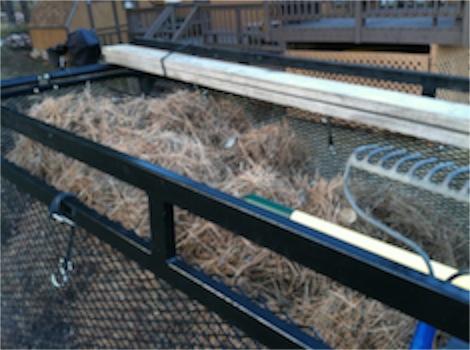
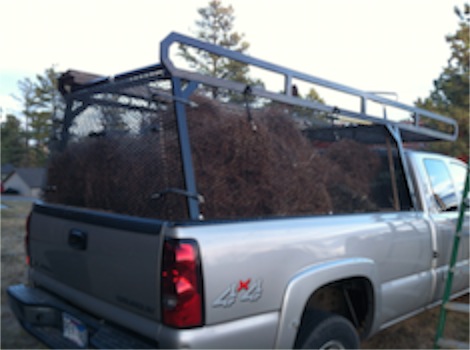
We’re not too big on outdoor decorations. We like to take care of our yard, but we celebrate holidays in a more private manner. We don’t go in for all of the lights and outdoor decorations. But we have neighbors who seem to get into the spirit of each season with lots of decorations. They have special lights for Halloween and different lights for Christmas. Their Halloween decorations go up sometime in September and they transition from Halloween directly into Christmas, usually having their Christmas decorations up well before Thanksgiving. But they are always careful to take those Christmas decorations down before New Year’s, which seems a bit strange because we are late to put up the Christmas tree inside of our home in order to make sure that it will last for all 12 days of Christmas. We never take our tree down before January 6 unless we need to travel away from home during that season.


So autumn has come to the hills. It is a beautiful time. And this morning, after I have unloaded all of those pine needles, I’ll go back to enjoying it. The job never seems too bad once it is finished.
I was right about one thing when we moved here: we are indeed lucky to live next to the forest, pine needles and all.
Copyright © 2012 by Ted Huffman. I wrote this. If you want to copy it, please ask for permission. There is a contact me button at the bottom of this page. If you want to share my blog a friend, please direct your friend to my web site.
Columbus, Indiana
There are many other notable features about Columbus, but one of the things I remember is the incredible architecture. Shortly after the Second World War, Cummins and others began to invest in architecture for the community. The company paid for local non-profits to hire world-famous architects to design their buildings.
 First Christian Church (Disciples of Christ) was designed by Eliel Saarinen in 1942. It is one of the first buildings in America designed in what has become to known as the modern school of architecture. The church features a 160-foot tall tower, a sunken terrace and a sanctuary that seats 900.
First Christian Church (Disciples of Christ) was designed by Eliel Saarinen in 1942. It is one of the first buildings in America designed in what has become to known as the modern school of architecture. The church features a 160-foot tall tower, a sunken terrace and a sanctuary that seats 900.First Baptist Church was completed in 1965 and was designed by Harry Weese. The building is designed in five distinct sections: narthex, sanctuary, office wing, fellowship hall and chapel. All of the buildings are constructed around a courtyard. There are classrooms in the office wing. The sanctuary is one of the first windowless sanctuaries I had ever seen. It is a simple A-frame and it does have light from skylights, but all of the interior lighting is precisely controlled.
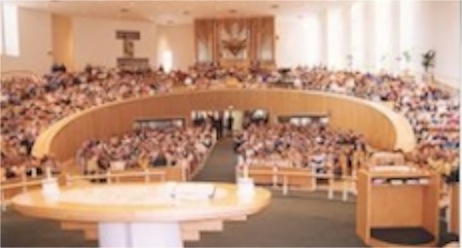

Our tour, a decade after the big building boom in the city, included a lot of other notable buildings. The Mabel McDowell School was the second building in town to have its architecture fee funded by the Cummins Engine Foundation. It opened in 1960 and was designed by John Carl Warnecke. It features a library with all of the furniture molded into the floor and walls, crawling tubes to connect various areas and lots of bright colors and natural light.
A lot of other public buildings benefited from the generosity of the Cummins Engine Foundation and hired top architects to design their structures. There is a library designed by I.M. Pei, a High School by Romaldo Giurgola, a Fire Station by Robert Venturi and a Myron Goldsmith newspaper office. The city also sports some significant public art including a fountain in front of the courthouse center.
At the time of our visit, I wondered what it might be like to live in such a place. Because our visit included an elementary school that was a striking contrast to any of the schools I had attended, I wondered what it might be like to be a child growing up in that community. Would being surrounded by such significant architecture make one more aware of and sensitive to art? Would one be more creative because of the surroundings? Would children growing up in such a safe and secure place be more likely to contribute to their state and nation? All of those things seem like possibilities.
There have been a few notable sports figures who grew up in Columbus. Basketball player and shoe designer Chuck Taylor grew up there. Race car driver Tony Stewart hailed from Columbus as does NFL player Blair Kiel. Chairman and founder of Sun Microsystems, Scott McNealy grew up in Columbus. So did Mr. Universe Bob Paris who is now a public speaker and best-selling author. The host of MythBusters, Jamie Hyneman grew up in Columbus. Fans of comic strips might recognize Bruce Tinsley, creator of the strip Mallard Fillmore. He is a product of Columbus, Indiana and its schools.
So Columbus does have its notables, but probably not more than other similar-sized cities. There is no evidence that having a choice of several very dramatic and powerfully-designed worship spaces has made the people of Columbus any more religious or more committed to living Christian values than those who worship in more modest surroundings. The effects of great art and great architecture are difficult to measure. Obviously the members of the Cummins Engine Foundation believed that such an investment in the community was a wise choice. It does demonstrate their faith in community and in the power of art to transform lives.
I wonder if people who grow up and live in Columbus are somehow disappointed with the rest of the world. Most of our towns have one or two notable buildings and lot of buildings that are copies of things built elsewhere or are primarily functional with little attention to art. A few of our sanctuaries are as inspiring and dramatic as those in Columbus. I know I am grateful to work and worship in a stunning building designed by Harold Spitznagel. He is probably most famous for Jehovah Lutheran Church in St. Paul, but I prefer our building over all of his other designs.
It is hard to say what the impact of all of the glorious buildings of Columbus, Indiana is on its residents, but it is a wonderful city to visit. We are affected by our surroundings. And there may yet be more to come from that city.
Copyright © 2012 by Ted Huffman. I wrote this. If you want to copy it, please ask for permission. There is a contact me button at the bottom of this page. If you want to share my blog a friend, please direct your friend to my web site.
The weather in Washington DC

It was amusing to me that when I moved from Chicago to North Dakota my Chicago friends couldn’t figure out why anyone would want to move to North Dakota. They made snide remarks about the low population, but they also made a lot of comments about the weather. They would say things like, “How could you stand the cold winters in North Dakota?” When we got to North Dakota, people would ask, “How could you stand the cold winters in Chicago?”
Then we moved to Boise. The main thing you can say about the weather in Boise is that there isn’t much of it. The city averages 360 sunny days each year. A couple of snowfalls and a rainy day or two and that is it. The winds are so light that I missed the sound of the wind. When we did get a thundershower, it was really small in comparison to what happens on the plains. The trees in our yard were so wimpy that they would lose branches if we got a wind gust over 20 mph.
And now I live in the banana belt of South Dakota. The weather is almost always a bit milder here in Rapid City than in other places in the plains. Our temperatures are not as hot in the summer or as cold in the winter as the eastern part of the state. We get a few storms and then the weather clears up. Our most severe blizzards occur in the spring. It’ll snow for a few days and then the sun will come out and melt everything off. We don’t have much to complain about.
I don’t pay too much attention to the weather in other parts of the country. I do notice the conditions in the places where I have friends. Since our daughter married into a family whose home is in Virginia, I have paid more attention to the weather in our nation’s capital. I’m beginning to think that the candidates for the House and Senate and White House aren’t really paying attention to the weather in Washington, DC. If they did, they might think about getting jobs in other places. Since the summer of 2010, when our daughter was married and I started paying attention, a lot of big storms have descended on her in-laws.

A blizzard shut down the evening commute on January 26, 2011. Some commuters found that their normal trip was stretched to six hours or more and when they got home the power was out because of the branches that fell on power lines across the city.

Five days later Hurricane Irene swept upon the capital, drenching everything in sight. The power was out from Virginia to North Carolina. I guess the brunt of the storm was in other places than the capital, but our family in DC had to brace for the storm and we were concerned.
On June 29, 2012 one of the most destructive complexes of thunderstorms in memory swept through the area. Packing wind gusts of 60 – 80 mph, the storm downed hundreds of trees and left more than a million people without power during the next few days when daytime highs exceeded 100 degrees. People had to empty their refrigerators and freezers and endure life without air conditioning as they waited for the power to be restored.
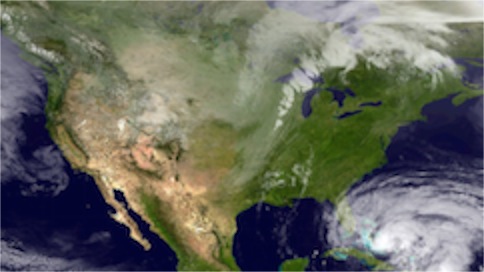
So I guess the folks in the nation’s capital need to stock the pantry shelves, check the storm kit and brace themselves for some nasty weather. It makes you wonder why candidates are willing to spend millions of dollars to try to get a job and a house in a place where the weather is so bad.
Back in the winter of 1945-46, delegates from around the world gathered in London to create the United Nations. Rapid City promoter Paul Bellamy proposed a location in the Imperial Valley, just south of Rapid City near the Stratobowl. He said that the delegates would think clearer out in the Black Hills. The natives have known for generations that people think more clearly in the hills.
Makes you wonder how different it might be if the nation’s capital were located in a place with better weather.
Copyright © 2012 by Ted Huffman. I wrote this. If you want to copy it, please ask for permission. There is a contact me button at the bottom of this page. If you want to share my blog a friend, please direct your friend to my web site.
Chard
One of the members of our church, cleaning out his garden on Wednesday, brought us a large bunch of Chard and a bundle of sage. We’ll dry the sage and use it throughout the winter, but Chard is best when it is consumed quickly. I’ve never grown Chard in our garden, but I suspect that it is easy enough to grow. It looks like a bit of a cross between spinach and beets. Like spinach, chard is grown for its stalk and leaves and not for its roots, like beets. It is often called Swiss Chard around here.
I think chard would make fine salad greens, but I decided to cook about half of the bundle we received for supper last night. I cut out all of the stems, chopped them up and sautéed them in butter along with a small red onion and a bit of garlic. When the stems were tender, I folded in the leaves and cooked just until they wilted. Then I added a bit of salt, lemon juice and Parmesan cheese. It made a great side dish to go with meatloaf for dinner. There is a small portion left that will be good for lunch today.
As summer slides into fall, we start to really appreciate the last bits of fresh garden vegetables. Things aren’t at all like they were for our grandparents’ generation or even our parents’. We have access to all the fresh fruits and vegetables we want in the grocery store every day. In our local store, apples are sold year round. Sometime in late August or early September the current year’s crop begins to show up, but they have ways of storing apples so that they will be selling the end of this year’s crop all the way until July or August of next year. Citrus definitely has seasons when it is better than others, but it is available nearly year round. Garden vegetables are all available throughout the year. The trucks that haul them from southern climates are kept busy by our appetites.
As I said, that wasn’t the case for previous generations. When I was a child, we always got a really nice orange in our Christmas stocking. It was a nod to a tradition that began just after the Great Depression in our parents’ homes. Oranges from Florida became available around Christmas Time in their hometowns if one met the right train bearing the fruit for sale. This practice was suspended during the war, but resumed in our childhood. As we grew up, oranges, grapefruit and other citrus became more and more available. These days, I expect to be able to buy lemons year round and we eat oranges or grapefruit almost every day.
In days past, the vegetables that were available during the winter were those that had been canned. Cucumbers became pickles. Some of the beats were pickled and others just canned. Peas and beans filled rows and rows of jars in the cellar. By the time we came along, fresh vegetables were not always available, but there was a huge variety of commercially canned vegetables. “From the valley of the (Ho! Ho! Ho!) Green Giant” was the jingle on the radio and television and our basement was filled with cases of canned goods that were prepared for nearly every meal. I don’t mind canned vegetables, but we rarely eat them these days because we have the luxury of plenty of fresh vegetables at our store. We consume most of our garden crops as they are grown and dry and freeze a few things. We haven’t gotten out the jars and canned things for ourselves since a member who asked us if we could use a few cucumbers came by with bags of them and we ended up with a dozen jars of pickles. We haven’t totally lost the skills of preceding generations, but we don’t exercise them much.
The crop that our parents most remembered from the hard days of the thirties is potatoes. They could grow large amounts of the tubers and filled their cellars with them. Then they proceeded to eat them. Our grandparents often ate potatoes three meals a day. Baked, fried, or mashed, and then re-fried as hash browns or potato patties for breakfast the next day. The cellars were cool and the potatoes kept pretty well, but as the winter stretched on and turned to spring, those old potatoes got pretty bad. Susan and I both remember the ritual of the first supper of creamed peas and new potatoes to celebrate the return of fresh. I don’t remember ever being served stale food, but I know that the memory of old potatoes was ingrained into my father’s memory.
But I do remember canned spinach. Whoever thought that was a good idea just wasn’t thinking. Popeye aside, I could barely get that stuff down. It was over-cooked and slimy. We grew up eating what was served and my mom worked hard to prepare food from the things that were in the freezer and pantry. Someone thought that buying few cans of spinach was a good idea. I suspect it was my father, who couldn’t resist a bargain. If the store marked down anything enough, he’d buy a case. At any rate, I grew up being able to imitate Popeye’s words: “I’m strong to the finish, ‘cause I eat my spinach.” I never shared his gusto for the canned stuff, though. I endured it.
I grew up thinking that I didn’t like spinach or chard or beet greens or anything that looked like that. What I discovered is that I don’t like canned spinach. That sautéed chard last night was a real treat!
By the end of this weekend, there won’t be enough chard left in our house to have any of it canned.
Copyright © 2012 by Ted Huffman. I wrote this. If you want to copy it, please ask for permission. There is a contact me button at the bottom of this page. If you want to share my blog a friend, please direct your friend to my web site.
Snow in the hills

So we got a little snow yesterday. It didn’t stick much in town, and there is just enough to turn to grass white here at home. Still it is good to get precipitation in any form. A mixture of rain and snow fell most of the day yesterday. It was enough to prompt us to reschedule a trip that we planned to take today to deliver firewood and a couple of used organs to our reservation partners. We don’t have access to an enclosed trailer and we felt that the organs might get wet. It turns out that it probably would have worked fine, but we’re hoping that we have a dry day next week to make the delivery.
I like the fact that we sometimes change our schedules because of the weather. These days we go through a great deal of our lives as if we are unaffected by the natural world around us. We have reliable heating and air conditioning in our cars in most buildings. The general mood seems to be one of charging forward despite the weather.
We have a meeting this morning with a company that supplies and services heating controls and equipment. We’ve been working hard at the development of a capital budget for major building upgrades and improvements. The process has been exciting. We are very fortunate to have inherited a building that was well designed and well maintained by those who went before us. Our congregation is free from debt and so has the capacity to engage in significant mission and outreach, while being comfortable in a building that serves us well. But that building is now over 50 years old. Some of the systems need to be upgraded in order to keep it serving the church for the next 50 years. So we’re making plans for the things we need to do to pass on the legacy that we’ve inherited.
One of the features of our building is that it has never had air conditioning. We’ve had a lot of discussion about air conditioning over the years, but to this date we have had other financial priorities. Air conditioning is expensive and there are only a few days each year when our building becomes uncomfortable. We have air handlers that move a lot of air and we can usually open up the building in the middle of the night and draw in cool air, keep it in the basement and then blow it up through the building to provide comfort. But there are a few days each summer when the sun heats the brick and block walls and the building becomes very warm. I know very well. The day of our daughter’s wedding was one of the warmest I’ve ever experienced in the building.
Still, there is a bit of reluctance to take the plunge and have air conditioning installed. One factor is money. It is expensive and whenever we spend money on ourselves, we have less money to invest in mission and outreach. It really isn’t a matter of simple math, because some money that is donated for building maintenance and improvements would not be donated for other projects and some money that is given for mission would not be donated for building projects. Still, money is a limited commodity in church life and we have to make decisions about our priorities. Serving others must always be our first priority.
But we haven’t stopped talking and thinking about air conditioning. One of the factors in our discussion is that we are trying to provide for the future. We hope that the investments we make in our building in this generation are of lasting quality and will serve future generations of our congregation. And, as one person put it, “Can you imagine that there will be any public building in our city ten years from now that isn’t air conditioned?”
The times are changing. Things that weren’t imaginable to our parents and grandparents are sometimes seen as necessities in this generation. I know that I have changed. In the early 1980’s, living in North Dakota, we felt that we had no need of air conditioning in our car, and we ordered a new car from the factory without air conditioning. Now, 30 years later, we have air conditioning in our cars and probably wouldn’t buy one without it. I remember the days when we had two small children in our home and felt that we had no need for a dishwasher. Doing dishes is a small job and it provides time for family conversation. Then we moved and the house we bought had a dishwasher in it. When it broke, we had become so used to it that we didn’t consider doing without. We bought a new one.
Things that once were considered to be luxuries are now considered to be necessities. I suspect that the people who planned and built our church building would be amazed by the office machines we take for granted and the amount of money we spend on them. Did anyone in the 1950’s believe that a church office would ever have a high-speed full-color printer in house? If our printer is down for more than an hour we feel like our work might grind to a halt. The distinction between the things we want and the things we need keeps shifting.
It is likely that the founders of our church didn’t imagine how fully we would use the building. There are activities planned in our building for nearly every day of the year. Children come and go to the preschool. Our educational programs include events on several days each week. The building is busy and full – and that is the way we want it to be. The building itself is one of the ways we serve the community.
I know that the day will come when we have air conditioning installed. We will be even less influenced by the weather than before. We will just keep going with our activities regardless of what is going on outside. I pray that we can be responsible with our decisions and find ways to operate the air conditioning as little as possible and consume as little energy as possible. I hope we make wise choices that result in long-lasting and sustainable equipment. The times change and we change with them.
So along with the improvements to the building, I am working to continue to develop outside spaces. We have a plan to plant more trees in the spring of 2013. We hope to continue to make places for outside worship and other activities. And we’ll keep cutting and splitting firewood outside.
Perhaps, in the future, people will ignore the weather. I suspect, however, that I’ll keep opening the door and checking the weather every morning.
Copyright © 2012 by Ted Huffman. I wrote this. If you want to copy it, please ask for permission. There is a contact me button at the bottom of this page. If you want to share my blog a friend, please direct your friend to my web site.
A small headache
But this blog is a sort of journal for me. I write it because I need to write as much as I write it for others to read. It is only Wednesday and I’m already worn out.
The few months have been a relatively hard time for our congregation. We’ve lost some of the pioneers and pillars of our congregation. We’ve also taken in a lot of new members, but it is still hard to say good-bye to folks who have given so generously of their time and energy to our congregation. There were days when we couldn’t imagine the church without those folks. Now we need to be a church in a new time – the time following their death. We have been promised that we will have everything we need to be a whole church. It is a gift of God. All it takes to recognize this gift is to stop complaining about what we don’t have and start recognizing the blessings we do have.
Yesterday was quite a day. On the one hand it was normal. I attended a book study, chaired a staff meeting, visited in the hospital and in homes and saw church members at the church. It is what I do. But it seems like it has been a kind of a hard time for our church.
And I have a headache.
Yesterday I sat with a member of our church in the Intensive Care Unit of the hospital. I heard the story of her husband’s surgery and how they discovered the aneurism at the last moment to allow for a successful procedure. An hour later and he would have been dead before they got him to the surgery suite. He is recovering and the prognosis is good, but right now he’s uncomfortable with a tube down his throat and unable to speak. And it was such a close call that it reminded us instantly of how vulnerable this life really is. After decades of marriage a couple comes face to face that they will one day lose each other. This life is not forever. A marriage is not forever. And most marriages end with a period of widowhood for one of the partners.
Time moves slowly in the ICU. The staff usually prefers for the family to leave during shift changes. Being asked to leave is a good sign, really. It means that your loved one is stable enough for you to take a break. Still at the bedside of a loved one is where one wants to be.
So I sat vigil for a while. We talked about a lot of different subjects. We expressed love and support. It is what the church is. We are a community of genuine care and concern. I was glad I was able to do that. But I do have a headache.
Yesterday I spent time with a church member who suddenly and unexpectedly lost a job. It is never easy to face unemployment, but when it comes without warning, it is a shock. To wake up one day thinking everything is normal and then find yourself unemployed, uninsured and uncertain the next requires a new way of looking at the world. After 15 years with the same employer, the swiftness and finality of the process leaves one reeling. Such cruelty is hard to imagine. But it is real. There are a thousand thoughts and worry. How will the bills get paid? What goes in a resume? How do I explain my unemployment? Who should I tell? Who should I avoid telling? What do I do tomorrow? The list of questions goes on and on and on.
I have a headache, but that seems like a trivial bit of information in the face of what happened in our church yesterday.
Yesterday I made a visit in the home of a couple that had just gotten the phone call about the biopsy results. To be fair, they both knew that cancer was the most likely explanation for what was going on. They were not shocked by the confirmation of a diagnosis that they already knew. Still there is something shocking about the diagnosis. And there are plenty of questions. Will the tumor grow? Will it spread? Will there be enough energy for chemotherapy and perhaps radiation treatments? What side effects will happen? Then there are the wider concerns. Should we sell the house and get a smaller place? What happens if the order of death of the marriage partners is different than anticipated? Until recently the primary caretaker was the one who now is a cancer patient. Is there energy to switch roles? Who will take care of whom? And all of those questions come before ones like, “Am I going to die?” or “What does it mean to die?”
As is often the case, the cancer patient expressed a deep spiritual faith and little fear about dying. The uncertainty of the days between now and death, however, seems a bit overwhelming.
And I have a headache.
Three families, three prayer shawls, three unique situations. A typical day in my line of work, I guess.

So I came back to the church in the late afternoon and was greeted by a basket of newly blessed prayer bears. We had the blessing of the bears on Sunday. Our children had taken all of the bears to the outside of the sanctuary. Then we had made a circle around the room and faced out and stretched out our arms as if we could reach beyond the walls of our building to convey the blessing of God that we had experienced to others in the name of Jesus. The bears are symbols of something much bigger.
I may have a headache, but I have my health and the health of my partner. I have a job and am fairly compensated for meaningful work. I have a reasonable expectation of a normal span of life.
And, when I open the door to the church this morning, there will be a basket of bears to greet me. Just knowing that makes me feel better already.
Copyright © 2012 by Ted Huffman. I wrote this. If you want to copy it, please ask for permission. There is a contact me button at the bottom of this page. If you want to share my blog a friend, please direct your friend to my web site.
The Seventies are Over
The headlines in the newspapers were bringing news of World War I when my grandfather turned twenty. They were reporting the Nazi invasion of Poland, the defeat of France and the beginning of the Battle of Britain during my father’s 20th year. The year our son turned 20, the attacks on the World Trade Center and the Pentagon topped the news.
The year I turned twenty, the end of the Vietnam War was making news as the US suspended all air activity and the first POWs were released. That year Elvis divorced Praiscilla, the OPEC Oil Embargo drove up the price of gas and AIM activists occupied Wounded Knee as United States Marshals and FBI agents cordoned off the area. Shots were frequently fired. The exact details of what happened have never been fully known. Two Native Americans were killed. One FBI agent was shot and paralyzed and later died from his injuries. This was a couple of years, a bunch of trials and a lot of dispute before the 1975 incident in which two FBI agents were killed in a shootout at a ranch where AIM activists were living. It was the second incident that resulted in the conviction and imprisonment of Leonard Peltier. Then in 1976 the body of Anna Mae Aquash was found on the Reservation.
Folks here in South Dakota have been arguing ever since about what did and did not happen, who was responsible and who was to blame for the events of those turbulent years in the 1970’s. It was during those years that I got married and moved away from the state of my birth for the first time. I was conscious of becoming an adult, trying to be responsible, and carefully reading the news.
It was a different set of events than those that shaped my forebears – and the events are unique and distinct from the ones that shape future generations.
But time moves on. We don’t live in the 1970’s any more. And if we had forgotten how much has changed, the events of the past week have invited us to remember and recognize how much change has occurred. Who would have predicted that George McGovern and Russell Means would come in the same week?
I am no expert and there will be plenty of others who will write about Russell Means. He certainly knew how to draw attention to himself and his cause. He lived his life as a warrior for what he believed to be the best interests of his people. He railed against broken treaties and acted in movies. He became a public spokesman in the midst of a bloody confrontation and he testified before congress.
I don’t know if Means was the first to call for the changing of sports teams, but he was one of the first persons I associated with that movement. He was constantly in the spotlight and he raised eyebrows in both the native and newcomer communities.
It seems trite, but it has struck me this week that the days of my young adulthood are really over. It should surprise no one. Four decades have passed. I’m three times as old as I was back then. New generations have come along. There are a lot of people in South Dakota who don’t remember what it was like before Russell Means was famous. There are a lot of people in our country who were born after the War in Vietnam and don’t know first hand the cultural upheaval and conflict that marked our country in those times. Current high school youth were toddlers when the 9-11 attacks occurred. Time goes on. Things don’t stay the same.
I suppose there will be nostalgia and remembrances as a part of the funeral services for McGovern and Means. I know there will be good memories along with the bad. I have my own memories as well. But it is time to put those days behind us.
There are still injustices suffered by Native Americans on South Dakota Reservations and in our own city. There is still institutional racism that is suffered by people. We have a lot of work to do before we have achieved our founders’ vision of “One nation, under God, with liberty and justice for all.”
But the days of picking up guns and firing them at each other as a way to achieve justice need to be put behind us. The days of replacing one form of paternalism with another have worn thin. Protests turned to standoffs are not what are needed to feed hungry children, provide equal education and opportunity, or address entrenched poverty. New times call for new methods and new solutions.
I will probably write more about it later, but I was struck with the contrast between the days of the 1970’s and a ceremony I attended Sunday in Pierre. We participated in the ordination of three Native American ministers. I don’t know of the United Church of Christ has ever ordained three Native Americans in the same ceremony before. The event was calm and dignified. Each of the men ordained could rightfully be called an elder. Each has demonstrated incredible pastoral leadership in his community. Each is distinguished in many different ways. But the word that I would use to describe all three is “humble.” Humility is a traditional Dakota and Lakota value. The three stand in stark contrast with those who have garnered the headlines. They have served their people quietly, behind the scenes, and without drawing recognition to themselves.
There were no television reporters at the ceremony. There were no reporters quick to grab quotes. It was a calm and quiet ceremony. It was as it should have been. The seventies are over. Public attention has faded. But the need for genuine servants remains. I am glad I was there to witness the dawning of a new day. I have great hope for tomorrow.
Copyright © 2012 by Ted Huffman. I wrote this. If you want to copy it, please ask for permission. There is a contact me button at the bottom of this page. If you want to share my blog a friend, please direct your friend to my web site.
George McGovern
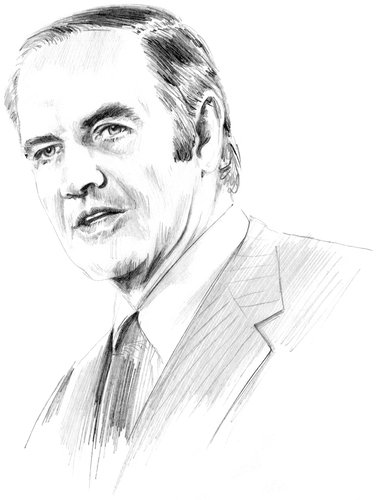
But there was a sense that things could change. People believed that their votes would make a difference. And there was a stark contrast in political philosophy between the candidates in 1972. The polls were clear. President Nixon was headed toward a landslide political victory. But I was young and idealistic. And I was captivated by the candidate from South Dakota who seemed so much like my father. George McGovern, like my father, had been a bomber pilot in World War II. Like my father that war had made him question war as a tool for international relationships. McGovern had studied theology after the war before becoming involved in public service. My father had a lifelong passion for religion and theology even though he never pursued those topics professionally. McGovern spoke of a different way of leading and called us to lives of service.
I voted. He lost the election. I have been diligent in voting ever since, never missing a presidential election. I’ve voted for those who won and those who lost over the years. I have never lost the sense that it is important to vote regardless of the winds of politics. I like to think that my political judgments are largely unswayed by the millions of dollars spent on advertising. I can make up my own mind how to vote and I prefer to do my own research.
The story that unfolded after McGovern lost the election is now part of our history. President Nixon resigned in disgrace after scandal rocked his administration. We were shocked at the foul language that was revealed in the tapes. We were shocked at the depth of the lies we had been told. I don’t think that we would be shocked any more. We have since grown very cynical about our leaders, about politics, and about government.
Despite all of that, George McGovern continued to be an integrity. He lost another important election, in 1980, running for this fourth term as US Senator. It was the beginning of a different time in US politics. Prior to that race, those of us who lived in small population states felt that we had control of our own election processes. In 1980 so many out-of-state dollars flowed into the election in many states that we have since known that powerful out-of-state interests invest far more in our local politics than we could ever afford. Every US Senate race in South Dakota since that time has been fueled by lots of money from other states. We’d like to believe that our votes are not for sale, but the truth is that buying a senator in South Dakota costs less than buying one in California and there are a lot of people who are willing to spend millions to buy a US senator, and virtually every senator owes favors to those who contributed to election campaigns.
In the midst of the rough and tumble and sometimes unfair realities of politics, however, George McGovern continued to believe in and work for the good of people. Some of his most important life’s work came from the phase after he lost the run for President. In the 1970’s, McGovern worked diligently on the Senate Hunger and Human Needs Committee, reforming the Food Stamp Program, expanding the school lunch program and establishing the Special Supplemental Program for Women, Infants, and Children. After losing his seat in the senate, McGovern continued to work to end hunger.
In 1998, after I had become a South Dakotan, President Clinton named George McGovern ambassador to the United Nations Food and Agriculture Organization. George McGovern went to work to strengthen global school feeding, nutrition and education programs. He continued to author legislation and to work with members of both political parties to provide leadership to our country. Long after both men had put their political aspirations behind themselves, he worked with Bob Dole to propose a program to provide poor children with meals at schools in Africa, Asia, Latin America and Eastern Europe. The 2002 McGovern-Dole International Food for Education and Child Nutrition Program was signed into law in 2002 by President George W. Bush and has provided meals to 22 million children in 41 countries.
“Whatever you did unto one of the least of these, you did unto me.”
There will be plenty of obituaries and eulogies and op-ed pieces written about George McGovern. There may not be much that I can add to the flood of words. But there is a lesson that I have learned from the life of George McGovern that I hope I can pass on to my children and grandchildren: Win or lose, don’t give up on your principles and values. George McGovern never gave up on his principles. He never gave up in his determination to call our nation to a higher plain. He never gave up on his commitment to serve others and to defend the most vulnerable. George McGovern never became president of our nation, but our nation is far better because of what he did. He served is country well.
“The first shall be last and the last shall be first.” History will remember George McGovern well.
His family has asked that we, instead of sending flowers or other tributes, express our support for them in this time of grief by contributing to organizations that are working to end world hunger. It is a grand gesture, and Susan and I have decided to make our memorial gift to Bread for the World. It is another lesson to learn from a wise man: Feeding hungry children is far better than winning an election any day.
Copyright © 2012 by Ted Huffman. I wrote this. If you want to copy it, please ask for permission. There is a contact me button at the bottom of this page. If you want to share my blog a friend, please direct your friend to my web site.
State bird


From there we moved to North Dakota. It also has the Western Meadowlark as its state bird. There are plenty of meadowlarks to go around. In fact the meadowlark is the state bird of six states: Kansas, Montana, Nebraska, North Dakota, Oregon and Wyoming.

And now we live in South Dakota. So this is the first time that I have lived in a state where the state bird actually spends the winter in the state. All of the other places that I have lived have had commuter state birds that go elsewhere during the winter. On the other hand, our state bird here in South Dakota isn’t a native. In all the other states where I have lived the state bird found its way to the state on its own. Here in South Dakota, our state bird was intentionally introduced. There was a time when there were no ring-necked pheasants in South Dakota. The reason they were brought to our state is one of the main reasons they remain popular in South Dakota to this day.
You see, South Dakota is the only place where I have lived where there is an official hunting season on the state bird. We eat them. They are delicious. Try doing that with a meadowlark, cardinal or mountain blue bird. It would take a mess of those little things to make a Sunday dinner for the family.
 Here in South Dakota the pheasant opener is a big deal. Officially it was yesterday, but the whole weekend is known as the opener around here. People have long-standing traditions around pheasant opener. They travel across the state to their favorite hunting places. There are family reunions, special events and long-standing traditions. The airports are crowded, their carousels are filled with shotguns, and the motels have been booked for months. We know that if we are going to schedule a church meeting for opening weekend we’d better not have it in Chamberlain or Pierre because there will be no motel rooms available. We notice the dip in church attendance on opening weekend. Some of our rural churches take advantage of the weekend to have fund-raising dinners. Feeding the hunters can be lucrative. Heck, I know a family that once delayed a funeral because of Pheasant opener.
Here in South Dakota the pheasant opener is a big deal. Officially it was yesterday, but the whole weekend is known as the opener around here. People have long-standing traditions around pheasant opener. They travel across the state to their favorite hunting places. There are family reunions, special events and long-standing traditions. The airports are crowded, their carousels are filled with shotguns, and the motels have been booked for months. We know that if we are going to schedule a church meeting for opening weekend we’d better not have it in Chamberlain or Pierre because there will be no motel rooms available. We notice the dip in church attendance on opening weekend. Some of our rural churches take advantage of the weekend to have fund-raising dinners. Feeding the hunters can be lucrative. Heck, I know a family that once delayed a funeral because of Pheasant opener.My perspective is a bit skewed, I suppose, because I am not a hunter. I don’t own a shotgun and I have only fired a shotgun once in my life. I’m not opposed to hunting when it is pursued safely, and I like to eat wild game, but I’m just as happy tramping through the woods with a camera as I would be with a gun. And, over the years, I have harvested my share of pheasants with the grill, bumper and headlights of my pickup.
One day last spring, Susan and I were driving on a busy freeway in Kansas City, Missouri. I noticed that a car had been following us for quite a while. When we got to our exit, that car exited. With each turn we made the car followed. When we got to our destination, I got out of our vehicle and the man who had been following us got out of his. He introduced himself and said he had noticed that we were from South Dakota and wondered if we had any good contacts for pheasant hunting. He said he’d sure love to have an invitation to come to South Dakota to hunt pheasants.
You see, not only did we import our state bird for the purposes of hunting. These days we also import hunters to go after our state bird. It is a bit confusing to those who don’t live here and appreciate our culture. We like playing host to visitors. If you are reading this and don’t live in South Dakota, please know that you are welcome any time. I’m sorry that I don’t have access to any of the favorite hunting places, but I probably know someone who could get you an invitation.
Back in 2001, when our nation was reeling from the attacks on the World Trade Centers and the Pentagon, there was a day in October when there was a front-page story in USA today that proclaimed, “Vice President remains in an undisclosed location.” The headline in our local newspaper that same day was, “Vice president hunts pheasants near Pierre.” Before that time, we didn’t know that we lived in an undisclosed location. I’ve been giving out my address to friends and relatives for years. On the other hand, we may have gotten a bit lax on security. It is a really safe place to live. And we are used to the cargo holds of passenger airlines on which we travel being filled with shotguns.
So be careful out there. Loaded shotguns can be dangerous and there are a lot of you driving up and down the dusty gravel roads. The land is dry and the fire danger is extreme. We want you to enjoy yourselves and we’d love it if you come back next year. Try finding another state where they serve the state bird at fancy dinners at the governor’s mansion.
Copyright © 2012 by Ted Huffman. I wrote this. If you want to copy it, please ask for permission. There is a contact me button at the bottom of this page. If you want to share my blog a friend, please direct your friend to my web site.
Post-colonial theology
Language is so important when it comes to understanding a culture. There are nuances of worldview that are built into a language. English, for example, doesn’t assign gender to many objects. Of course there are gender words pertaining to humans and animals, but other European languages assign gender to inanimate objects and speakers have to remember appropriate prefixes. Lakota has word variations, primarily suffixes, that shift depending on the gender of the speaker. It isn’t quite true to say that there is a language of men and a different language of women, but there are ways of speaking the belong to the genders.
It could be argued that there is little reason for a middle-aged person of European descent to try to learn Lakota. English is the dominant language of our culture. It is also the dominant language of the reservations. Less than 14% of Dakota, Nakota and Lakota people speak native languages. The average age of a Lakota speaker is 60 years old. It is clear that despite significant efforts to teach the language at the high school and college level, fluency in Lakota is declining and the language is on the brink of being lost.
There is an immersion preschool for 3-year-olds on the Standing Rock Reservation and plans are underway to open a day care program for children from 15 months to 5 years in Pine Ridge. Children who are immersed in a language at a very early age learn it as a primary language and retain fluency throughout their lifespan. However, it is unclear how effective the 3-year-old program will be as the children grow up and attend English-based primary schools. The simple fact that Lakota is not spoken at home creates significant challenges for teaching it to even very young children.
Our experiences yesterday weren’t primarily focused on language. English was clearly the language of our conversations. What are doing is continuing a process of gathering to speak frankly about race and racism, to discover places where we can work together, to speak out for justice and reconciliation between the people of South Dakota.
Our history is a long journey of not being kind to each other. That sentence is, of course, a radical understatement. The invasion and seizure of native lands by settlers, primarily form Europe, was accompanied by genocide. There were concerted efforts to wipe out the indigenous people of this continent. Multiple massacres left deep scars. The destruction of the buffalo herds destroyed a way of life. Boarding schools ripped children from families and stole their language, history and culture from them. Broken treaties destroyed trust. Other factors, perhaps not intended, contributed to the trauma suffered by North American native people. The advent of European settlers introduced new diseases for which the natives had no immunity. Epidemics ravaged communities. There might be some debate about whether or not smallpox was deliberately introduced to native communities there is no debate that the disease had devastating effects.
The exiling of the remnant people to reservations decreased contact between natives and non-natives. Early mission efforts by the church were accompanied by a paternalistic attempt to supplant indigenous culture with the culture of the missionaries.
The simple truth is that terrible things have been done in the name of the church. So, today, we who have inherited that legacy and who seek to continue the work of the church, have a lot of work to do to heal ancient wounds, to address issues of grave injustice, and to discover new ways of thinking bout our mission and ministry. Reverend Norman Jackson challenged us yesterday to be diligent in our work on a “post-colonial theology.”
What I have learned from nearly three decades of living in the Dakotas is that one of the most important parts of my role in the process is listening. I need to be present at the gatherings, witness the work that is done, and listen. The last thing my Lakota and Dakota sisters and brothers need from me is for me to attempt to speak for them.

Singing the songs of faith together seems to be the best teacher of the language for an old man like me. I don’t always understand every word, but I do understand the faith and I know a lot of the words.
I think “Jack” Jackson is right. We need to develop a new theology. But the hymnody of that new theology may be the sounds of a hymnal that has been around for nearly a century.
Copyright © 2012 by Ted Huffman. I wrote this. If you want to copy it, please ask for permission. There is a contact me button at the bottom of this page. If you want to share my blog a friend, please direct your friend to my web site.
Wind
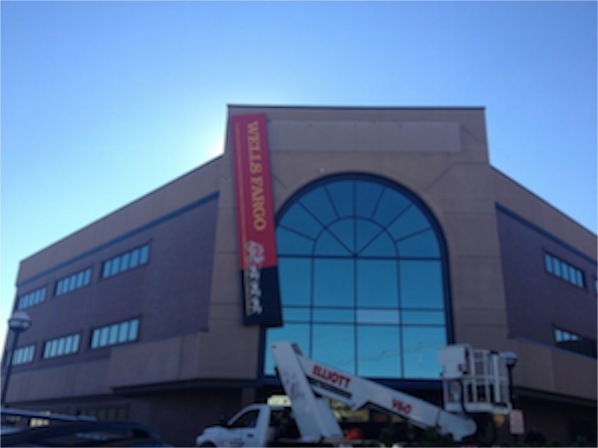
We could hear the sound of chainsaws in the late afternoon yesterday as people began cleaning up.
I grew up in windy country. My home county is known for high winds. We had a few windy days one year that picked up enough sand and gravel that we had to have vehicles painted. There was a time when companies refused to move mobile homes on a particular stretch of the Interstate west of our town. I’ve been around the wind enough to know that the fact that we had no damage at home or at the church yesterday was due only in part of preparations – it was also due to luck. We could have had a blast of wind take out one of our trees, or peel a few shingles off of our roof. We were lucky and we’ll get opportunities to help our neighbors who weren’t as lucky.
This morning the quiet is delicious.
In a few hours we will be headed out to Placerville, our church camp near Johnson Siding. Our colleagues began a retreat and a time of sacred conversations on race last evening. We were not able to join them due to our church’s board meeting, but we will be with them for breakfast today and spend the day and evening taking advantage of the opportunities for connection, learning and networking. These are important conversations as we continue to seek new avenues of shared ministry in a place where the wounds of violence are still fresh. The process of settling our state involved the injustices of colonialism and the paternalistic attitude of some of those who sought to do ministry on the reservations further deepened the wounds and the divide between natives and newcomers.
The work of peace and justice is often a slow process of talking and listening and then listening some more. Not long ago, I was speaking with member of a congregation from Missouri who was very proud that he was making his third trip to a South Dakota reservation. He boasted that his church was in their seventh year of a twenty-year commitment. I smiled and thought to myself that I guess I am in my 17th year since moving to South Dakota, and you can add at least 7 years in North Dakota. Our church is more than a century into a commitment that has no end date. I am grateful for congregations who make a 20-year commitment. There is far too much spiritual tourism and hit-and-run missionary activity on the reservations. Relationships are what are needed, not charities.

So I am looking forward with great anticipation to a celebration on Sunday in Pierre, when we will participate in the ordinations of three native pastors who have served long and faithfully in their communities. I have been honored to call them friends and colleagues. Now it will be my distinct honor to call them “Reverend.”
Sometimes the wind blowing across the prairie is indeed the Holy Spirit: Ruah, Pneuma, the Breath of Life.
Copyright © 2012 by Ted Huffman. I wrote this. If you want to copy it, please ask for permission. There is a contact me button at the bottom of this page. If you want to share my blog a friend, please direct your friend to my web site.
No other gods
The first of the Ten Commandments is clear. Free people worship only one God – the true God, the God who led the people out of the bondage of Egypt. Freedom comes from worshiping only one God. The commandment Exodus 20:3 is repeated in Deuteronomy 5:7. It is echoed in the Shema – the great commandment – of Deuteronomy 6:4: “Hear O Israel: The LORD is our God, the LORD is one.” Jesus quotes it as the first and greatest commandment in the Gospels.
We have been able to say the commandment for generations. Living it has been a much more difficult challenge. At the end of the era of judges, when human failings and corruption among our leaders was evident, the people begged for a king. God finally relented and allowed for a monarchy – and what a monarchy we got! The great king David was an adulterer, murderer and liar. His successor, Soloman, had too many wives to count and amassed such a fortune to the palace that he was unable to see the poverty of his people. The institution of monarchy collapsed in a series of divisions, intrigues and finally sheer military defeat. It was more than three centures after the banishment of the priests to Anathoth before the prophetic voice of Jeremiah was heard with clarity.
We read the history of our people and think that we are somehow different. We think that we are too smart to fall into idolatry as the people in the wilderness. We would never worship a golden calf! We think that we would never embrace a monarchy as those in ancient Israel. We are citizens of a democracy.
But we continue to put human beings on pedestals and treat them as if they were somehow bigger, better, stronger, smarter, or in other ways different from others. We place human heroes alongside our religious icons and worship them. And we seem to be shocked when they are proven to be somewhat less than God.

Another celebrated sports hero joined the ranks of those discredited. It seems that the public only loves a cheater when the cheating remains hidden.
But there are some things that remain, even after the spectacular public reversal of fortunes. The guy was a pretty good bike racer. Somewhere in his life he got some things right. Serving others whose lives are forever changed by cancer is not a bad investment of time and resources. He did some good through public advocacy and hid generosity in starting the Livestrong Foundation is commendable.
The man wasn’t a god. But he isn’t pure evil, either. He is human.
Here is the part that is so hard for us to take. We participated in the spectacular events of his demise. We celebrated each of his bicycle racing victories and clamored for more. We wanted to believe that he was superhuman. We wanted a hero who was invincible and we embraced the image of a man who could beat anything. We even helped sponsor his racing team, a bit of an embarrassment now that it appears that the use of banned substances by the US Postal team predated Armstrong. It was a part of the culture of cycling competition.
We forgot our first commandment: “You shall have no other gods before me.”
We don’t only do it with sports heroes. We do it with politicians.

The truth is that presidents, even very good presidents, are human beings. They have failings. They make mistakes, whether or not they admit them. They experience errors in judgment whether or not they are caught. If you expect salvation to come from the President, you will be sorely disappointed.
“You shall have no other gods before me.”
The Center for Responsive Politics has estimated that the total spending for the 2012 election will be $5,803,829,964. I’m not sure how they come up with an exact dollar figure, but $5.8 billion is serious money. “For where your treasure is, there your heart will be also.” (Mt. 6:21, Luke 12:34) To claim that idolatry was some ancient practice of our forebears is to close our eyes to the realities of our current situation. It may not be a golden calf, but a $5.8 billion election is a serious detraction from one true God.
I have been paying attention to the campaigns. I will vote on Election Day. I will try to be informed and careful with my vote. But I do not expect either salvation or damnation to come as a result of the election.

Copyright © 2012 by Ted Huffman. I wrote this. If you want to copy it, please ask for permission. There is a contact me button at the bottom of this page. If you want to share my blog a friend, please direct your friend to my web site.
Stories they used to tell
They used to say that the Grand Canyon was the result of Paul dragging his axe as he wandered across the southwest. Mount Hood is just the result of him piling rocks on his campfire to put it out. He had similar campfire at Mt. St. Helens, but he didn’t actually get the fire put out. Had he been around in 1980, he would have just stamped it out before it blew. Of course that would have caused the Columbia to drain into the depression until it filled up the hole he had made and former mountain towns would have become lakefront towns.
They used to say that it took two redwood trees to make Paul Bunyan’s skis and that he would ski so fast that it would speed up the rotation of the earth and make the days shorter in winter.
They used to say that Paul Bunyan could eat so many pancakes at a sitting that it took half the wheat in Canada to make the flour and 50 men working full time mixing up the batter and another fifty to feed the fire under the griddle. They used to say that old Paul would cut slabs of bacon so thick that they’d strap the bacon to the boots of men and have them skate around the griddle to keep it greased. They used to say that Lake Superior is the hole left when they mined the iron for that great griddle.
They used to tell the story about the time when Paul Bunyan decided to lend a hand with the corn harvest in Iowa. He took to the fields with an axe in each hand. He’d sharpened those axes so well that he could slice a tomato by throwing it up into the air with one hand while swinging the axe with the other. His axe was so sharp that he would throw a log up with his right hand and his axe with his left and when that spinning axe hit the tree it would rain toothpicks on three counties at the same time. They used to tell that when Bunyan was harvesting corn in Iowa he could clear a hundred acres in an hour. He chopped corn so fast that the ears all landed in Nebraska and the stalks landed in Oklahoma. He chopped corn so fast that one day the ears were going through the air so fast that they heated up so much that the corn all popped and fell in Kansas. The people saw that corn floating down and thought it was a blizzard and hundreds froze to death caught outside and not expecting winter to come so soon. Of course that was in the days when the corn in Iowa grew so high that it poked holes in the milky way and the light used to leak out so much that the roosters would look up and think it was the sun rising and crow at midnight, which caused the Iowa farmers to get up and go to work. That in turn made the corn grow even higher. They had to attach ropes to the top of the cornstalks so they could pull the tops down and bend the corn over to make room for the moon to pass by each night.
They used to tell that Paul Bunyan only went fishing once. He was somewhere out on the west coast, Oregon or Washington I guess, and he kept hooking blue whales. Now Paul was partial to blue, having such a good friend in Babe the Blue Ox. Besides he thought those whales were really cute so he decided that they were too small to be keepers and he released every one that he caught. He never did catch anything big enough for him to keep and so he got bored with the whole enterprise and never went fishing again, except for the time he visited Norway and got his foot stuck in a fjord. He asked for some corn oil to grease his foot so he could get it out, but his Norwegian was not good and the people thought he was asking for vinegar. He poured the vinegar in the water around his foot and produced ten years’ supply of pickled herring.
They used to tell stories like that, but not so much any more.
Copyright © 2012 by Ted Huffman. I wrote this. If you want to copy it, please ask for permission. There is a contact me button at the bottom of this page. If you want to share my blog a friend, please direct your friend to my web site.
Death comes again
He died as a result of the injuries.
There is no doubt that his assailants intended for him to die. Their attack was cruel and without mercy and has been described in the media too many times. It must have been traumatic for the other officers who discovered him. It must have been traumatic for the ambulance workers who rushed in and attempted to provide lifesaving care and transport to the hospital. It must have been traumatic for the emergency room personnel who tried without success to revive him.
It is impossible to understand or describe how awful it must have been for his widow and children.
His death was clearly an injustice. No one deserves to die the way he did. He did nothing to justify the brutal attack. He was just doing his job – a job that he was good at.
Death is permanent. It cannot be taken away. RJ will not be returned to this life. He will never have a retirement with his widow. Lynnette has to face an entirely different future than they had imagined. His grandchildren will grow up without getting to know their grandpa the way he would have liked. The reality is tragic.
I have no right to tell his survivors how to feel. If they are angry, they have every right to be so. If they are struggling with the meaning of life, it is completely understandable.
I know that I share a little bit of the guilt for his death. I am a citizen of the State of South Dakota. RJ worked for us. He was a prison guard. For whatever reasons, we didn’t provide for his safety on that fateful day in April, 2011. I know that not every danger can be identified. I know that all peace officers take risks to perform their duties. But providing for the safety of its citizens is one of the primary functions of government. Every time someone falls victim to murder, we have in some way failed.
There has been plenty in the press about the two men who attacked RJ. Eric Robert and Rodney Berget were both inmates in the prison who hatched an escape plan. The plan involved getting a guard’s uniform and they were willing to commit murder to get that uniform. Both have confessed to their crime. Robert asked for the death sentence and tried everything in his power to expedite his own execution. Berget is appealing the death sentence.
Last night, we put Eric Robert to death. The execution was conducted in accord with all of the procedures outlined in South Dakota statute and after the mandatory appeals had taken place.
One news story reported that the judge who handed down the sentence concluded the sentence by saying, “May God have mercy on your soul.” I trust God with the soul of Eric Robert. I never met the man. I know nothing about him other than what has been reported in the news. My prayer is a bit broader than the judge’s: “May God have mercy on the souls of all of us.”
We wake this morning after the death of Eric Robert and go on with our lives. Lynnette Johnson is still a widow. Nothing will bring her husband back to her in this life. The officers who work at the South Dakota State Penitentiary still have risky jobs and still face dangerous persons. There are no guarantees that another won’t be attacked. Sudden and traumatic death will enter the lives of South Dakotans in a wide variety of ways in the year to come. Some will lose loved ones due to accidents, others due to attacks, others due to suicide. Too many people will experience the loss of a loved one that they didn’t anticipate. Too many people will face grief that is overwhelming and undeserved.
And we can argue until we are blue in the face about whether or not we accomplish anything with the death penalty. Do state executions make grief any easier? Do they make the citizens of the state any safer? The debate can rage on and on with intellectual arguments made on both sides. I have my opinions, and I haven’t kept them to myself. I will continue to wade into the debate when I feel that I can make a constructive contribution to our common conversation.
But I can never be self-righteous. It would be disingenuous for me to claim that I somehow am smarter, more understanding or more righteous than any of the other citizens of South Dakota. The peace officers, the judges, the victims and the perpetrators – we are all flawed individuals. None of us is innocent.
I didn’t fasten the straps that attached Eric Robert to the gurney last night. I didn’t guide the needle into his vein. I didn’t handle the syringe that was used to inject the fatal chemical. But I participated in his death. I am a member of this society. I am a citizen of this state. I am a part of the body of people who have consented to the government that did our bidding. Had I been in charge, a different decision would have been made. But I am not in charge. I am a member of the corporate body – a citizen of the state.
I cannot escape the feeling that we haven’t got it right. In a way it seems unjust that for Eric Robert it is over when others have to live the rest of their lives with the results of his actions. At a bare minimum, we owe it to ourselves not to forget.
May God have mercy on our souls.
Copyright © 2012 by Ted Huffman. I wrote this. If you want to copy it, please ask for permission. There is a contact me button at the bottom of this page. If you want to share my blog a friend, please direct your friend to my web site.
Live music
I remember clearly the first time I experienced a “walkman.” It is likely that the device was an imitation and not the Sony original, but it played cassette tapes through a set of wired headphones. The device was relatively expensive at the time. Not every student had one. The first one I saw was brought onto the bus by a student who sat next to one of the biggest players on the football team. They shared the device, with each using one of the ear buds of the headphones. The football player insisted that the rest of the bus be quiet so he could hear. It was an amazingly quiet and wonderful drive.
I joke about it now, but it was an amazing experience to live through two major transitions in personal music. The first transition was the advent of portable music devices. I don’t think that we had any battery-powered music devices in our home when I was growing up. My father was a dedicated builder of “Heathkit” stereo components, so we had a fairly fancy stereo in our living room that played records. My sisters had a small record player that I’m sure was labeled “portable,” but it needed to be plugged into an outlet to play. When I was older, there were transistor radios that ran on batteries and though their sound was less than ideal, music became portable. I lost a portable radio once when it was confiscated for being wired into the school pa system. We did, however, get to listen to listen to more than three innings of a World Series game between the St. Louis Cardinals and the Boston Red Socks before school officials found out why the game was being piped throughout the school. At the time it seemed worth the sacrifice, even though we all knew that the Red Socks probably wouldn’t win. The series did go a full seven games that year, though.

The personal stereo changed a lot in a short amount of time. A few years later, we had moved out of the city and students began to listen to their music privately through headphones. From cassettes, the industry transitioned to CD’s. Both of our children went through several different personal CD players over the years. I got pretty good at replacing the ends of the headphone wires when they were damaged, but we still bought more sets of headphones than players.
These days there are a lot of people connected to MP3 players. More and more these players are not devices dedicated to music only, but are also telephones. There are telephones available that will hold thousands of songs. Some youth have their entire music library on their iPod or phone.
Music listening has become a very personal experience. A school bus these days has nearly as many different songs as there are youth on the bus. Each one is carrying his or her personal soundtrack.

There is no recording device that could capture the experience we shared. I went away from the concert with one of Tao Lin’s CD’s. I’ll probably transfer the sounds to my MP3 player. I have recordings of Perce Kagari Emata and Jim Szana that were made in our sanctuary on our piano. But the recordings are not at all the experience of sharing live music with an audience.
There is no technology yet invented that can reproduce the joys of sharing live music with our neighbors. Quite frankly, I like it this way. There is no way I would trade being in the room for a pair of earbuds.
Copyright © 2012 by Ted Huffman. I wrote this. If you want to copy it, please ask for permission. There is a contact me button at the bottom of this page. If you want to share my blog a friend, please direct your friend to my web site.
Sabbath
I know that my behavior is not completely atypical. It is increasingly common for young adults to remain constantly connected to their mobile devices. I am not very active on twitter or facebook. I don’t keep up the constant connection to social media, but there are those who are constantly monitoring those sites. I’ve frequently had the experience of posting an announcement on one of those sites and receiving an immediate reply.
I think that things are even more intense for people in their twenties and thirties. They are starting their adult lives in the midst of a shortage of decent-paying jobs and an atmosphere of fear about unemployment. They do not feel valued in their employment and carry worries about debt and financial problems with themselves wherever they go. Their mobile devices keep them constantly on a tether to their work and advise them about the condition of their financial affairs on a minute-to-minute basis. There is never a time when they can let down their guard and relax.
It’s no wonder that many young adults struggle with depression, anxiety and disconnection that come with living at a breakneck pace.

In the midst of those trying times, we received commandments from God to guide us on our path toward freedom. One of those commandments was to remember the Sabbath and keep it holy. It was, to be sure, a spiritual commandment. It also was a lesson in practical living. Each week can be punctuated by a day of conscious abstaining from the distracting, the noisy and the ordinary. Instead, our people are invited to carve out time to focus on family, community, relaxation and reflection. For at least one seventh of our lives, we can put away our wallets, park our cars, shut down our digital devises and try our best to live like we already have everything we need to be happy and fulfilled.
I have caught myself thinking that I need to have more. I look at the balances in my retirement savings and feel that I need to save more. I look at the items that are for sale and I think I want to acquire more. I make a grocery list and head to the store to replenish the supplies in the pantry and I want to have more. There is a serious problem with the desire to have more. It cannot be fulfilled. No matter how much I save, no matter how much I acquire, the desire for more cannot be satisfied. The solution is to learn to be happy with what I have.
I am not a big shopper on any day of the week. I don’t spend much time in stores. But I know that there is a 24-hour grocery store between my home and the church and I have been known to stop for supplies on any day of the week. My need to have constant shopping available contributes to the situation that requires the employees of the store to work in the middle of the night and on Sundays. Of course I’m not a big enough customer to dictate store hours, but it is for the convenience of people like me that the store stays open.
The commandment is simple: spend one day consciously avoiding technology and commerce. Instead refocus on life’s simpler joys. Instead of counting Twitter followers and Facebook friends, spend time with community members and loved ones. In place of the constant barrage of information and responsibilities, one day could give room to breathe.

It isn’t just young adults who need to heed the commandment. It is all of us. Despite the experience of thousands of years of our people, there is still much that I have yet to learn.
Copyright © 2012 by Ted Huffman. I wrote this. If you want to copy it, please ask for permission. There is a contact me button at the bottom of this page. If you want to share my blog a friend, please direct your friend to my web site.
The Weather in Australia
It is spring in Australia and people are beginning to think about trips into the mountains, where the cool air provides some relief from the cities. The people of Katoomba are gearing up for another summer of tourists seeking out the mineral baths and hot springs of the area.
The Blue Mountains have a reputation for snow in the winter, but Katoomba lays at a low enough altitude that snow is relatively rare. They may see a few flakes on five or so days each winter, but a frost blanket is a more common. June is the coldest month of the year in Katoomba, with average daytime highs in the 50’s, if I’ve translated from Celsius correctly. By October, the weather is warming. The record cold temperature for Katoomba in October is around 30 degrees.

Of course it was not all sadness in Katoomba. The kids headed out for snowball fights and a few snowmen could be spotted around town. One father of a four-year-old commented that it was the first time his daughter had ever seen snow.
Elsewhere in Australia, the weather was generally stormy, with large swells forcing the candellation of the Manly ferries. Surfers were warned that conditions were dangerous with waves reaching 25 feet at Port Kembia. There were even a few sightings of snowflakes around Canberrra, where temperatures were well below average for October.
Things are expected to return to normal today as warming temperatures return the typical spring weather. When the winds die down, the Aussies will return to their usual and start heading for the mountains or the beach.
I sort of wish I had been there to see the kangaroos in the snow.
One of the joys of having friends in distant places in this era of instant news is the daily reminder that the way things are here isn’t the way they are everywhere. We’re expecting unseasonably warm temperatures for the middle of October today. Highs should be above 70, which means we’ll be splitting wood in t-shirts by noon. Our Saturday splitting party at the church will be relatively light duty for those of us who participate because one of our splitters is in the shop. There was a lot of work accomplished over the summer and we don’t know how severe the winter will be, so right now it looks like we have a good supply of wood split for our neighbors.
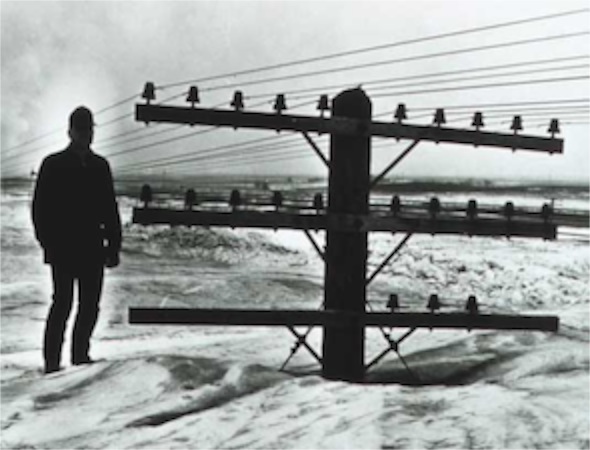
The people in North Dakota have it right, of course. We cannot control the weather. We have to live with whatever comes. And enduring drought or blizzards or rainy days is easier if your attitude is positive. Knowing that whatever we are going through is not the norm, we can take an attitude of surprise to the present and anticipation for the future.
The world is changing. Part of the change is the weather. Global weather systems operate on a scale that we do not fully understand. Changes in temperature are affected by a lot of different factors. We may be contributing to changes in the climate through our use of fossil fuels and other choices we have made. But even the best of our scientists is a bit unsure of what the consequences of those behaviors might be. There are folks who can easily predict terrible outcomes. There are others who believe that this planet and its systems are more resilient than others.
I’m all in favor of trying to live more responsibly. I try to decrease my consumption of fuels, live simply, and not make things worse for others. I am careful with the choices I make at the store. We are in the process of down-sizing and reducing our consumption.
And I hope to keep working on my attitude. Whatever comes, I hope I can be as surprised as a Katoomba preschooler who looks out the window to discover snow. And I hope I can bring a North Dakota attitude to even the hardest days. After all, this is unusual weather for us. It usually isn’t like this.
Copyright © 2012 by Ted Huffman. I wrote this. If you want to copy it, please ask for permission. There is a contact me button at the bottom of this page. If you want to share my blog a friend, please direct your friend to my web site.
Sheep

“The Senegalese are really into their sheep,” says Fadilou Keita. Keita, who is 28 years old lives with six sheep in his Dakar home. He is a financial analyst with an iPad in one hand and the other hand in the mouth of a sheep. “This is my passion,” he says.
So, if you don’t remember, I have a different relationship with sheep in my life. I grew up in Sweet Grass County, Montana, once known as the wool shipping capital of the world. There were plenty of sheep ranchers in our community and lots of sheep on what we called the “government pastures” in the high country of the Boulder Valley and other areas of the Gallatin National Forest. I’m sure that there were plenty of lambs brought into homes, especially when a spring blizzard lined up with early lambing. In fact we knew that when they are tiny, baby lambs can’t climb out of a bathtub. This is information that I have never had reason to test or use, but it seemed to be common knowledge in the culture in which I grew up. People took sheepherding seriously. It was commonly known that the Court Bar was the hangout for sheepherders and cattle buyers had better get their drinks at the Grand Bar down the street. To cross that boundary was to invite a fight. I was about eight years old when the last fight to my knowledge that involved stepping out into Main Street and firing pistols at each other erupted. Only one of the combatants died.
 The Court Bar is no longer there. The Grand is the anchor of an upscale remodeling of the entire hotel. The Timber bar is still in a prominent position on Main Street. You can guess the profession of that establishment’s historic clientele. Hint: the sign has a guy wearing suspenders wielding an axe. The old Moose Club is now a place that serves mostly fancy hamburgers and deep fried green beans with something about a lizard in its name. I could go on and on about the bars in the town where I grew up. We had a lot of churches, but there were always more bars than churches in my town.
The Court Bar is no longer there. The Grand is the anchor of an upscale remodeling of the entire hotel. The Timber bar is still in a prominent position on Main Street. You can guess the profession of that establishment’s historic clientele. Hint: the sign has a guy wearing suspenders wielding an axe. The old Moose Club is now a place that serves mostly fancy hamburgers and deep fried green beans with something about a lizard in its name. I could go on and on about the bars in the town where I grew up. We had a lot of churches, but there were always more bars than churches in my town.  This has little to do with sheep, but sheep were an important part of my town. After all the mascot of the local high school is still the sheepherder. The school logo sports a bearded buy in an old hat and kerchief smoking a pipe. Smoking may be banned in all of the schools in Montana, but in my hometown, the high school mascot still smokes his pipe. It was good enough for us when we were kids and there’s no reason to change it now, I guess. I know there’s no local support for taking the pipe away.
This has little to do with sheep, but sheep were an important part of my town. After all the mascot of the local high school is still the sheepherder. The school logo sports a bearded buy in an old hat and kerchief smoking a pipe. Smoking may be banned in all of the schools in Montana, but in my hometown, the high school mascot still smokes his pipe. It was good enough for us when we were kids and there’s no reason to change it now, I guess. I know there’s no local support for taking the pipe away.20 miles down the road is Reed Point, still in the county, and home to the annual Great Montana Sheep Drive, featuring hundreds of woolies charging down Main Street. Main Street in Reed Point is only six blocks long. Sometimes they have to turn the critters around and run them back up the street in the opposite direction. The occasion does involve a lot of beer and a high demand for porta potties. Eat your heart out Pamplona.
All of which is to say that I have shoveled my share of sheep manure. I’ve stepped in the stuff, fallen in the stuff, and washed it out of my hair. I know the reek of ram urine. The desire to have a pet lamb in my home has never been an experience that I have sought.
But pet sheep are a big deal in Senegal according to Yahoo! News. There sheep are given names and kept inside homes. Ousmane Ndiyae could rent out the upper story of his home for at least $500 a month. Instead it is home to their beloved ram Billai and 10 other sheep. The animals are on the top story of the building so they can have access to a sunny outdoor terrace well above the commotion of buses and vendors below. They are fed leftovers from the family table in addition to a mixture of corn, millet, beans and sorghum.

We have a cat who lives in our home. The animal is pleasant enough, and I admit that I have grown attached to it. But it is a bit of a chore to care for. The litter box needs to be emptied regularly. There is food and clean water to provide. The cat sheds on everything, which means more housework. And it is an expert at tipping over any container left out in the garage. It is a challenge to keep the cat away from drying epoxy or fresh varnish when I am building boats.
But today, I’m thankful for the cat. Our daughter brought it home because she fell iin love with it. Had we lived in Senegal, she might have come home with a lamb.
Copyright © 2012 by Ted Huffman. I wrote this. If you want to copy it, please ask for permission. There is a contact me button at the bottom of this page. If you want to share my blog a friend, please direct your friend to my web site.
70 and counting
 Food supplies were short in many part of Europe. Despite the bombings, despite the danger, despite the shortages they themselves were experiencing, a group of people got together in Oxford to see what could be done about starving children in Greece. They formed the Oxford Committee for Famine Relief. Sending relief supplies to starving women and children in Greece meant coming up with a strategy to get the supplies through the allied naval blockade.
Food supplies were short in many part of Europe. Despite the bombings, despite the danger, despite the shortages they themselves were experiencing, a group of people got together in Oxford to see what could be done about starving children in Greece. They formed the Oxford Committee for Famine Relief. Sending relief supplies to starving women and children in Greece meant coming up with a strategy to get the supplies through the allied naval blockade.The committee, meeting at St. Mary’s Church on High Street in Oxford, decided to fund their efforts by donating their own household items and selling them in a gift shop. It wasn’t easy clearing the political landscape of the time, but they persisted. The early years were tough, with the group often at political odds with the majority of the citizens of England. In 1945, the Save Europe Now campaign was launched to persuade the UK government to allow food parcels to be sent to Germany. Sending food to the enemy, even after the defeat of Germany, was not a popular action. But women and children were starving and the group felt a need to respond to a genuine humanitarian crisis.
Oxfam has been responding to crises ever since. Today the group has more than 700 shops in the UK, supported by 22,000 volunteers. I guess we should be congratulating the present leaders of the organization on the occasion of their 70th anniversary. But celebrating seems to be the wrong mood.
Oxfam is still crossing political barriers to bring food to hungry people.
 Thousands of people are seeking refuge in Kibati, on the outskirts of Goma in the eastern part of the Democratic Republic of Congo. Conflicts in that country are devastating the lives of many and the internal refugees are facing severe shortages of food and water.
Thousands of people are seeking refuge in Kibati, on the outskirts of Goma in the eastern part of the Democratic Republic of Congo. Conflicts in that country are devastating the lives of many and the internal refugees are facing severe shortages of food and water.Oxfam has commissioned a short film to examine how the illegal arms trade is threatening the basic well-being of people around the globe.
Sudan’s Comprehensive Peace Agreement was signed in 2005, yet southern Sudan remains one of the poorest regions on earth. The people hope that peace will bring development, but in the meantime, emergency food supplies are a thread by which many are clinging to life.
Oxfam is responding to food crises in Somalia, Pakistan, Yemen, Niger, and Assam.
70 years after its founding, it seems that the need for emergency food relief is as great as ever. 70 years after its founding, there is little to celebrate. Dame Barbara Stocking, who has been the head of Oxfam since May, 2001, said, “In many ways, 70 years of Oxfam is not really a cause for celebration. We will only really be able to celebrate when there is no more need for Oxfam, when everyone in the world has enough to eat and extreme poverty and suffering are consigned to history.”
Right now it appears that the celebrations are a long way off, indeed.
The phrase “perfect storm” is often used these days after Sebastian Junger wrote a book about the 1991 Halloween Nor’easter storm. The phrase may have been brought to popular culture by the Junger’s book and the movie based on the book, but the phrase has been around a long time. The Oxford English Dictionary has published references to “perfect storm” going back to 1718. It’s first use was to describe applause. In Junger’s book it was describing a weather phenomena. These days we use the term to refer to almost any kind of complex combination of factors. They say that Somalia is at the center of a “perfect storm” of poor rains, crop failure, death of livestock and political insecurity.

People who were just barely coping with drought conditions and high food prices a year ago are now facing literal starvation without humanitarian support. They need to be given food in order to survive. Development is needed, but first the people need enough food to stay alive. Skipping meals is the norm across large parts of Somalia.
Somalia is just one place where relief is critical to the survival of starving people.
Four years after the formation of Oxfam, 37 denominations in the United States banded together to form Church World Service. The mission of CWS is to provide sustainable self-help, development, disaster relief, and refugee assistance around the world. Like Oxfam, Church World Service envisions a day when hunger and extreme poverty are eliminated. Unfortunately that day seems to be a long way off.
Both Oxfam and CWS have discovered that disaster response and refugee assistance can be intensely political actions. Like the Prophets of the Bible, leaders of hunger relief organizations have found out that it can be dangerous to call for justice and peace. Even giving blankets to people suffering from exposure to the elements following a disaster can be far more political than it would seem possible.
So this month I am noting the anniversary of Oxfam, but we have no celebrations planned. We’ll be preparing for our Blankets Plus offering to be taken in November as we join with about 8,000 congregations throughout the United States to support efforts to combat hunger and suffering caused by natural and political disasters. If that is getting the church involved in politics, so be it. Like the brave people who started Oxfam, we refuse to be silent while children are starving.
This Sunday we will once again read the story of a rich young man who went away from Jesus saddened because his wealth prevented him from following Jesus. Mark’s gospel reports that Jesus loved that man. By the standards of the world, we are the rich people. Like the man in the Gospel, we have to free ourselves from the things that prevent us from becoming disciples. It is a challenge that will not easily disappear from our lives.
Copyright © 2012 by Ted Huffman. I wrote this. If you want to copy it, please ask for permission. There is a contact me button at the bottom of this page. If you want to share my blog a friend, please direct your friend to my web site.
Big Adventures
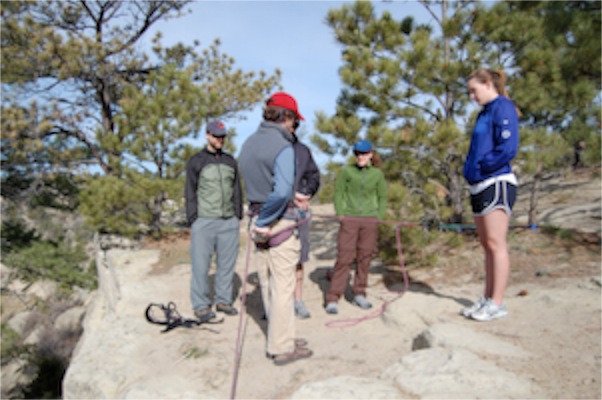
College students undertake much more arduous adventures these days. I don’t think that technical climbers even use the term “rappel” very often. The common term these days is “abseiling.” Abseiling comes from the German, abseilen, meaning “to rope down.” Abseiling is used in mountaineering and also in certain industrial activities such as building maintenance, construction, bridge inspection and the like. Search and rescue teams use the technique to assist those who have fallen or need help as the results of accidents. Abseiling from a helicopter is used both in rescue operations and certain military operations. By using a descender the rate of descent can be easily controlled. The climber wears a climbing harness to secure him or her self to the descender.
That is virtually everything I know about abseiling. I’m not a rock climber. So I was intrigued recently to see that the word has become associated with kayaking. No, there isn’t a technique for hooking onto a descent rope while sitting in a kayak. The abseiling technique is used to get the kayak and the paddler down over a waterfall to access the river below for a whitewater adventure in a place that is not accessible by any other technique. There seems to be something in the spirit of whitewater kayakers that attracts them to stretches of water where no one else has before paddled. Usually these are fast-moving streams at the bottom of canyons.
Richard Bannister is a 35-year-old dentist whose goal is to abseil the highest waterfall in the United Kingdom, the Falls of the Glomach in Scotland, then kayak the gorge below. The plan is for the adventure to unfold in about a month. There is plenty about the adventure that involves an encounter with the unknown. An emergency exit from the kayak leaves a combination of wading, swimming and climbing as the only means of getting out of the canyon. An injury means that the same adventures have to be undertaken with the injury.
Some people seek out risk and find it be exciting.
Graham Hughes is attempting to visit every UN-recognized country in the world without flying. He’s traveling only by land and by sea. So far he has been arrested in Cameroon, Guinea, Cape Verde and Congo on charges that range from spying to people smuggling. So far he has gotten released each time he has been arrested.
Graham Hoyland is trying to be the first person to have climbed the highest mountain on every continent and also sail the seven seas. The seven peaks have been climbed by some. The seven seas have been sailed by others. Hoyland wants to be the first to have done both.
Norman Surplus is attempting to be the first person to circumnavigate the globe in a gyrocopter. He’s been grounded in Japan since 2011 trying to get permission to fly over Russia.
There are people who have invested their entire life savings in caving adventures, jungle explorations, mountain climbing in war zones and all sorts of other adventures. I haven’t signed up for any of them, yet.
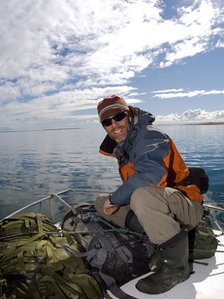 I’m too old and probably could never get into good enough physical shape, but I am attracted by the adventure of Kevin Vallely, of Vancouver, Canada, who plans to row the Northwest Passage from west to east starting in July of next summer. The team is hoping to complete the row within three months. That is about as long a weather window as they will get. They plan to form two-man teams so they can row 24 hours a day in shifts. Until recently, the Northwest Passage was accessible only in steel-hulled ice-breakers. Throughout the 19th century voyageurs and explorers tried without success to find the elusive water route across Canada. Until very recently no such passage existed. Travelers had the choice of a series of very long portages, including some intense mountain passages, or going so far north that they traveled on ice. But the world is warming up. If Vallely’s team succeeds it will be a personal triumph for the team, but it will also be a clear sign that the world has changed. The dramatic environmental changes that have opened up the passage each summer have consequences that we do not fully understand.
I’m too old and probably could never get into good enough physical shape, but I am attracted by the adventure of Kevin Vallely, of Vancouver, Canada, who plans to row the Northwest Passage from west to east starting in July of next summer. The team is hoping to complete the row within three months. That is about as long a weather window as they will get. They plan to form two-man teams so they can row 24 hours a day in shifts. Until recently, the Northwest Passage was accessible only in steel-hulled ice-breakers. Throughout the 19th century voyageurs and explorers tried without success to find the elusive water route across Canada. Until very recently no such passage existed. Travelers had the choice of a series of very long portages, including some intense mountain passages, or going so far north that they traveled on ice. But the world is warming up. If Vallely’s team succeeds it will be a personal triumph for the team, but it will also be a clear sign that the world has changed. The dramatic environmental changes that have opened up the passage each summer have consequences that we do not fully understand.I shan’t be going on any of those expeditions. I’ll follow a few of them from the comfort of my home using my computer.
My personal goals seem to lie in other arenas.
I’d like to be a member of a team of people who lower the suicide rate in Pennington and Meade counties of South Dakota. It will take a long-term commitment, involve raising funds, demand teamwork and vigilance and perhaps even a bit of luck. It is a really big goal.
I’d like to be a member of an expedition that journeys with persons of differing abilities working for justice, work with dignity, fair pay, and access for those who live with chronic disability. Using a wheelchair for mobility shouldn’t mean that you have fewer human rights than your neighbors. Being born with a cognitive disability shouldn’t mean that you are forced to live with strangers in a group home. That journey is a long road and we’ve only taken a few steps.
How about a quest for a community where everyone who worked full time was paid enough to live above the poverty line? That would require inventing new systems, envisioning a different economy and probably tackling fierce challenges such as human greed, corruption, and prejudice.
I may have a few years behind me, but I think I’m still up for some really big adventures.
Copyright © 2012 by Ted Huffman. I wrote this. If you want to copy it, please ask for permission. There is a contact me button at the bottom of this page. If you want to share my blog a friend, please direct your friend to my web site.
Sociology
The farm crisis and we arrived at about the same time. We watched as family farms were sold to pay debts. Large farm and ranch operations got larger. The number of students in the schools got smaller. Local businesses struggled to make ends meet. Some businesses went on the market and no buyers could be found. The county where our churches were located and the two neighboring counties across the South Dakota line from which we drew members all experienced the most dramatic decrease in population since the Great Depression of the 1930’s. Those were hard times. And they were good times. Our churches were wonderfully supportive of new and inexperienced pastors. They were also wonderfully supportive of members who found themselves in transition and sometimes in crisis. Both congregations experienced modest growth in the seven years we served as pastors.
I knew the truth, that our experience was an ananomoly, but there was a part of me that smugly (and a bit arrogantly) believed that we had proven our professor wrong. We did beat sociology – for a brief time.
Our experience has to be put in the context of the bigger picture. Now, 27 years after we left those congregations the larger of the two is no longer a church. The church building has been sold to a funeral home. The parsonage that was our home has long since passed into private ownership. The other congregation is still operating, but with somewhat irregular services provided by a part-time lay minister who commutes in from out of town. Each funeral causes a conversation about whether or not the church can survive to the next one. Attendance is less than 20 when they do have a service.
You can buck a trend for a while. You probably can’t beat sociology.
So I read studies with care. When I was called to be pastor of this congregation, a little over 8% of the people in the United States claimed no religious affiliation. In the latest study from the Pew Research Center that number has risen to 19.6%. Nearly one in five Americans answers the question about their religion as “nothing in particular.” The numbers are even more alarming when you look at age. One third of adults under the age of 30 claim no religious affiliation. Harvard political scientist Robert Putnam, who has written at length about the decline in religious affiliation, believes that the decline is due, in large part, to disagreement with the political positions taken by the religious right and a perception that most churches have similar attitudes towards science and politics as the fundamentalists. It is a little hard to follow his argument that the decline in mainline Protestantism is due in part to a reaction to fundamentalism in non-mainline congregations, but I have had direct experience with people whose perception of the church is nowhere near the reality of the congregation I serve. They expect the church to be dogmatic, judgmental, opposed to all scientific discovery, and politically partisan. When people do experience our congregation, they often express surprise at its openness, diversity, intelligence and education.
Sociology however remains. The fastest growing religion in America is “nothing in particular.”
We live in a society that is marked by the fleeing of institutions in general. The decline in church participation is matched or exceeded by the decline in membership in service clubs, hobby clubs, alumni associations – even bowling leagues. People are less likely to join or become affiliated with any club or group.
A sociologist would look at our congregation’s growth spurt and strong financial performance as a temporary anomaly, not a trend. They would predict that decline is the general trend for all congregations, especially well-established institutions like ours.
I have no doubt that the church of the future will be vastly different than the present expressions of institutional religion. The Christian faith has never dealt with success very well. Jesus didn’t set out to form an institution. He was deeply critical of established religious structures. He focused on relationship and never measured success or failure in traditional terms. The church has often been at its best in times when the world thought it was failing. Faithfulness does not require big buildings, big numbers or big budgets.
Here is what I think is missing from the data in the Pew study: many of those who claim no religious affiliation are people of faith. Just because they choose not to express their faith by forming an alliance with a particular institution does not mean that they do not pray or that they lack belief. And those people, like others, long for genuine community. Big institutions often are not the strongest expressions of community. The success or failure of our congregation lies not in the huge trends of sociology, but in how well we serve the needs of our people. Can we meet their needs for community? Can we minister to the realities of their lives? Can we be there for them when they are grieving?
Human beings are, at their core, spiritual beings. And we are all on a journey that involves real spiritual challenges. Death is a part of this life. Loss and grief are inevitable. Regardless of religious identification or affiliation, there is a need for the work we do. I can’t predict the future of the institutional church. I can’t predict the future of the congregation I serve. But I can predict that walking with fellow human beings through the struggles of this life will continue to be meaningful work whether the institution is weak or strong.
I guess my teacher was right. You can’t beat sociology. But it is equally true that there are many important things in life that sociology can’t study. Fortunately we have been called to be faithful, not to be successful in the eyes of the sociologists.
Copyright © 2012 by Ted Huffman. I wrote this. If you want to copy it, please ask for permission. There is a contact me button at the bottom of this page. If you want to share my blog a friend, please direct your friend to my web site.
Disabilities Awareness

Our friend John Thomas likes to say that he became a member of the United Church of Christ when he flunked out of Methodist Sunday School. I don’t know many of the details of John’s childhood but the story behind the story is that at some point in his youth, he started to go to church with his grandmother instead of his parents and she went to the Church that John has belonged to ever since.
John was labeled as a disabled child early in his life. His cerebral palsy mad it difficult for him to learn to walk and his movements are at times jerky. I don’t know if it is the result of the challenges of schooling and the primitive nature of special education programs when John was a child, or something that is more deeply ingrained in his personality, but John is challenged by some social situations. He speaks a bit more loudly than is appropriate at times. His sense of personal distance is much closer than is comfortable for some people. His conversation sometimes is very direct and lack subtlety.
But John has a good heart, an able understanding of Christianity and the life of the church, and he is a loyal and dear friend.
John is one of many friends who have taught me a great deal about living and working with people who are differently-abled. I know that “disabled” is the popular term, but it doesn’t quite describe people who define themselves not in terms of what they cannot do, but in terms of what they can do. Another friend, who has used a wheelchair for mobility since a bullet fired randomly struck him in the back and left him without the use of his legs when he was five, reminds me frequently that I belong to what he calls the “temporarily-abled,” community. As we age, we all discover limitations. Some of those limitations are physical and others are intellectual. Our memories don’t work as well as they once did. We experience pain in places where we never felt it before. It doesn’t take much time visiting elders in nursing homes to realize that canes, walkers, scooters, wheelchairs and other adaptive devices are probably in all of our futures. In my case, add in eyeglasses and probably before too many more years hearing aids.
The question is not whether or not we will experience disability. The question is how we will define our lives. When U.S. Senator Tim Johnson suffered a stroke, his political opponents were quick to point out what he lost in the stroke. He speaks more slowly and deliberately than was the case before the stroke. What they failed to realize is that speaking and thinking are not the same thing. He still thinks and understands clearly. In some ways his slowness of speech has made him more effective in his job simply because he listens more carefully than before.
The Americans with Disabilities Act was a landmark piece of legislation first signed into law in 1990 by President George H.W. Bush. Among the witnesses to the signing was UCC pastor Harold Wilke, who had no arms, but who was very at home in his own body. When President Bush handed Harold the pen used to sign the act, Harold calmly took it in his toes and blessed the President. Harold also offered the invocation for the day. This is his prayer:
“The festivals of the religious year
show forth new meanings for access and liberation:
In the glory of Easter- the stone rolled away –
we see the barrier removed.
In the wonder of Pentecost the message is heard
understood, and seen by all.
In the liberation of Passover the message is:
‘Let My People Go!’ and the parting of the Red Sea.
In the joy of Advent, God embodies divinity in human form.
“Yet for many persons today –
who are blind or deaf or have mental retardation
or who are in wheelchairs –
the barriers still remain.
The stone is still in place.
The waters are not parted, the way not opened.
The words cannot be heard.
The flame of the Spirit’s tongues cannot be seen,
the message is not understood.
“Proclaiming the message in all languages for today
means using technology or larger print
for persons with visual disabilities,
signing or special sound systems for persons
with hearing disabilities,
image, color, and drama for
people with cognitive disabilities,
architectural access for
people with physical disabilities or who are getting older.
“Let the stone be rolled away!
Let the glorious message be proclaimed truly, in all languages
So all may hear and understand.”
There are those who say that the church shouldn’t be overly involved in social issues, who fear the church becoming too political and too divisive. But there is a part of our religious tradition that is firmly rooted in the call to governments to become more just. Moses standing in front of Pharaoh was a political act, but it was also a religious act. Jesus’ silence in front of Pilate can be seen as a sign o meekness, but it is also a powerful witness to the simple truth that God is more powerful than any human government. Harold Wilke’s consistent call for justice for those who are disabled might be viewed by some as too much mixing of politics and the pulpit. But his work was intensely religious.
Harold died in 2003, but there is much work that remains. As we recognize October as the month of disability awareness, we all need to look at issues of access to all areas of human life and the barriers we construct that limit the participation of people in our society.
I am not the voice of people with disabilities in our community. Those living with disabilities do not need me to speak for them. My role is different. I am called to walk alongside my sisters and brothers as they advocate for themselves. I am called to be a friend and to listen more than I speak.
And I join in the prayers of so many others that our church will continue to extend an extravagant welcome to those who are often seen by the world as limited or handicapped. Surely the fullness of God’s image is shown in the lives of those who have been labeled as disabled.
Copyright © 2012 by Ted Huffman. I wrote this. If you want to copy it, please ask for permission. There is a contact me button at the bottom of this page. If you want to share my blog a friend, please direct your friend to my web site.
On Divorce
There is much about a Sunday like today that is good. Words are not the only way to show respect and reverence for God. Words are not necessarily the best way to worship. In the hectic rush of our world, silence is often a better approach to worship than speaking.
The gospel text for today, however, is very challenging. There is quite a bit that could be said about it. In the gospels, Jesus doesn’t use harsh words very often. Today’s reading from the 10th chapter of Mark contains some pretty strong language. I suspect that there are more than a few preachers who be tempted to shy away from the gospel reading and reflect on Job and why the good suffer – an easier topic for the contemporary church than divorce. In the passage, Mark 10:2-16, Jesus clearly speaks against divorce and remarriage. Our congregation, like many others has many people who have experienced a divorce and a remarriage. We are fearful of offending good and faithful people who are a part of our community. It is a bit of a dilemma.
A look at the context of the passage is always good when exploring the text. Jesus and his disciples are on the road to Jerusalem. Crowds gather. Religious leaders try to set Jesus up with a trick question. It is important to note that controversy over divorce and remarriage is not something we invented in our generation. People have been wondering about it and arguing about it since long before Jesus. The fact that divorce is a subject that needed to be addressed by Deuteronomy demonstrates that it has been an issue for millennia. So the question is a good trick question to pose to anyone who is in the public eye. There is no “good” answer. However Jesus answers the question he risks offending part of his audience. It is a little like the dilemma before a contemporary preacher who addresses this text. It is easy to offend someone.
Jesus begins his answer by reviewing the law. The questioners quote Deuteronomy. These days, when we read Deuteronomy we are struck by the rigidly patriarchic culture of the time. The law doesn’t address women at all. It speaks of divorce as the province of men without any consideration for the women and children involved. So Jesus, when confronted by the Pharisees, changes the subject from divorce to marriage. He quotes Genesis and points them to God’s intention for two people to be faithful, lifelong companions in an intimate, committed relationship that should not be severed.
But there is a private conversation that follows. The talk about “adultery” doesn’t come in the conversation with the Pharisees, but only later, when they are in the house. “In the house,” is the way that the writer of Mark records the conversations that were going on within the early church. Jesus then speaks of something that is not addressed in Deuteronomy: a wife divorcing a husband. In this conversation within the early church, the focus shifts from the moment of divorce to the reality of a society like ours. When a society permits divorce and remarriage, as our society does, we need to come to terms with the fact that the bond of marriage is not always easily or completely broken. There are plenty of legal arrangements that put a date to the end of a marriage, but feelings and connections remain. And when we take the children seriously, we understand that some forms of on-going relationship are necessary.
In the contemporary church, we need to acknowledge not only the reality of divorce, but also the pain and on-going struggles that accompany a divorce. Our response needs to be one of compassion and a call for justice. All of those affected by divorce need to be given a voice and whatever laws or conventions we adopt must consider the wider ramifications of divorce. In our congregation we often see the effects of divorce on parents and grandparents of those whose marriages end in divorce.
At the same time the church needs, like Jesus, to shift the focus. There is something essentially good in marriage. Despite the dismal statistics about divorce in our contemporary society, marriage is a good thing – a positive relationship. Marriage is one of the places where we have an opportunity to encounter God. The experience of marriage is an experience of God’s grace. Taking marriage seriously in the church means upholding the sanctity of the relationship and the depth of commitment “for as long as we both shall live.” It also means that the church should hesitate and think very seriously before denying anyone this means of encountering God. Withholding marriage is as serious as denigrating it.
Then, in that “in the house” conversation, Jesus changes the subject once again. The famous passage about welcoming children follows right after the harsh words about divorce and adultery. Maybe the scene was chaotic. Maybe the disciples were tired and in a bad mood. Who knows why they spoke sternly to the children or their parents. Whatever the context, Jesus once again reminds the first disciples and us as well that children are not excluded from God’s gift of grace. He asserts the basic equality of all ages before God, something that it not evident in the harsh legal code of Deuteronomy.
How often I have felt that the courts forget the children when they contemplate the breakup of a relationship. How often I have believed that the courts are the wrong place to handle family disputes. As is often the case, Jesus speaks directly to our generation as clearly as he did to his first followers. We do well to continue to wrestle with the texts as we discover new meanings for our lives.
Copyright © 2012 by Ted Huffman. I wrote this. If you want to copy it, please ask for permission. There is a contact me button at the bottom of this page. If you want to share my blog a friend, please direct your friend to my web site.
The Process of Writing
Kerouac cut sheets of tracing paper into long strips, wide enough for a typewriter. Then he taped them together into a 120-foot long roll that he fed into the machine. He was a very fast typist, able to type over 100 words per minute. Still the story emerged in one surge, without chapter or even paragraph breaks. He wrote nearly continuously for 20 days with his wife supplying him with pea soup and coffee to keep him going. Without having to load pages the story unrolled as he went.
 The original manuscript is currently on display at the British Library in London. They formed a special display box and unrolled the entire scroll so that members of the public can look at the manuscript. This is only the third time that the entire scroll has been rolled out.
The original manuscript is currently on display at the British Library in London. They formed a special display box and unrolled the entire scroll so that members of the public can look at the manuscript. This is only the third time that the entire scroll has been rolled out.The scroll differs from the finished novel in many ways. It begins with a typographical error. The scroll says, “I first met met Neal.” The double word error is one that I frequently make when I write. The difference is that we tend to self-edit as we write when using computers. The machine alerts us to many different kinds of mistakes and we go back through our words as we write.
It is nearly impossible to get inside of that immense burse of creativity that went through Kerouac as he produced the book. He simply kept the words flowing.
Kerouac has long been recognized as a chronicler of the beat generation. His coming of age novel has been read by a half century of American youth. It has taken longer for appreciation for his true artistry as a wordsmith to emerge. The writing reveals a deep appreciation for the English language and a wide and colorful vocabulary.
As interesting as all of that, it seems to me, is the mental process that produced the book. For less than a month in April of 1951, Kerouac so fully lived the story that it was all he did. Except for brief and irregular periods of sleep, he simply wrote. He too his sustenance from a cup that his wife sat beside the table where his typewriter was scrolling through that enormous roll of paper. Typing is a physical activity, requiring more pressure and strength in the fingers and hands. A good typist develops a rhythm that allows the process to continue.
In a way, it is sad that we don’t have a sound recording of the process. Imagine being his wife, Joan, living in the same home as that incessant noise. When he finally did stop, the silence must have been deafening.
I’m curious about the processes within us that produce language for others to read. Unlike Kerouac, I am not much for continuous writing. At writers’ workshops I have done an exercise of continual stream-of-consciousness writing. The exercise is usually done with pen and paper and one writes without interruption for a half hour. It is hard to keep the pen going. I find myself writing about my desire to pause and consider what to write next. I like to think out what I am going to say before I begin to write. I often have the first and last sentence of a daily blog in my mind long before I sit at the computer to write. When I am in the flow, I have the beginning and ending of the blog in mind before I go to bed the night before so that I can mull the ideas. Even on days, like today, when I rise without knowing what the topic of the blog will be, I often dig into a previous experience. I read the article about the Kerouac manuscript going on display in the British Museum yesterday and have been thinking about it since.
I guess all writers wonder where ideas come from. I know I do.
There are a few days when I wake without a clue what I am going to write about. The discipline of writing an essay every day has become a routine, but there are vast differences in the amount of time that it takes me to write. Some days I can produce the essay in 15 to 30 minutes. Some days I work and work to produce something in two hours and then am disappointed with the results. I go through seasons when my blogs seem to be repetitive. Sometimes I get a run of humor going. More often, I fall back into the general realm of philosophy. When I begin to get a bit too personal with my reflections, I pull back and look for a topic focused on some other person or situation.
I am never unaware that others read by blogs, but the primary motivation for writing isn’t for recognition. The number of people willing to read these long reflections is not large. Most popular blogs are a quarter of the number of words I write each day. I write in part to teach myself to write. I want to become an essayist and the only way I know to learn is to do. But I also write to process my experiences and thoughts. I think that is what Kerouac was doing when he sat down at his typewriter and fed the leading edge of a 120-foot scroll into the roller. He was trying to understand the experiences he had. The book has names that have been changed and sections that have been edited from the original. The manuscript is much more of a reflection on a real trip that actually took place.
Processing an experience that has been lived into words that can be communicated is part of a larger process of extracting the meaning from experiences. The philosophers call it “Phenomenology.” My first published article in 1977 was titled “Meanings Emerge,” and was an exploration of how young children discover and interpret meaning from their experiences. All these years later I continue to wonder and think about that same process. Maybe if I continue to write an essay a day for the next 35 years I might produce something as significant as Jack Kerouac write in 20 days one April.
Copyright © 2012 by Ted Huffman. I wrote this. If you want to copy it, please ask for permission. There is a contact me button at the bottom of this page. If you want to share my blog a friend, please direct your friend to my web site.
Singing a New Song

Birdcalls are even more complex than the variation between different species of birds, though. The scarlet tanager, one of my favorites, has a different call in the East, where woods are denser than they do out where we live. Scientists have observed that birds in San Francisco have raised the pitch of their songs over the past 40 years of observation. Birdsongs can be more easily heard over the traffic now than was the case when observations were first begun.
The context in which a bird finds itself is a factor in the nature of its song.
I think that this is not just true of birds. It is true of us as well. We behave (and probably sound) differently in different contexts. I know that I am that way. When I am in a new situation that is unfamiliar, I tend to be quiet and reflective. I try to listen very carefully and speak infrequently. As I become more familiar with a setting, I share my opinions more freely and speak more often. I suspect that some people, who do not know me very well, have found me to be quiet and even a bit shy. Others would find that description to be foreign and inaccurate.
Adaptability is one of the great qualities of the natural world. Plants and animals change to respond to the realities of their context. If this were not the case, many would not survive changes in the environment.
It may have always been true, but the time in which we find ourselves seems to particularly call for adaptability in the structures of the church. The way that churches organized themselves, budgeted their resources and provided for leadership in the past will not work in the current environment. Churches that insist on doing things “the way we’ve always done them,” are headed toward decline – maybe even towards extinction.
The change is exciting and keeps those of us who work in the church engaged and learning. We know that recruiting volunteers is different than it was when we began our careers. We know that the shift from programs to events is irreversible and that the coming and going of participants is inevitable. We are learning to live with intense schedule competition and over-committed families. The world is simply different than it was when I began to serve as a pastor.

Those of us who are living out our lives in the midst of the established institutional church are not, however, stuck in the same place. Sure there is the tendency of an institution to stay the course and resist change. There is a nostalgia that can sometimes get in the way as people attempt the impossible task of recovering some of the things from their past. It is a hard lesson for some folks to learn that the reason our churches were full in the 1960’s and 1970’s was the product of sociology, not best practices. Returning to the programs of those decades does not result in returning to the numbers of those decades. But there is a voice or two advocating for such a return in almost every generation of church leaders.
The writer of Hebrews declares, “Jesus Christ is the same yesterday, today, and forever.” The same is not true of the church. The church is constantly changing and evolving as circumstances change. Like the birds, our song needs to be different in different contexts.
Ross Snyder wrote, “We will walk with a truth that is ever before and sing the Lord’s song in an ever-strange land.” The pursuit of the truth of God leads people into new contexts and situations. It leads congregations into new patterns of organization and new ways of doing their work.
As our congregation prepares for a Mission Festival on Sunday, I have been deeply aware of how mission has evolved in the last couple of decades. It was not long ago that we thought of mission primarily as a series of programs that were set by national and international leaders of the church. We would receive news of outreach programs and projects from other settings of the church, often accompanied by slick brochures and full-color bulletin inserts. Our congregation would respond with generosity to appeals. These days, the larger part of our mission consists of projects that arise from the congregation. Many of our mission projects started with an individual coming to church leaders and asking, “what if . . .?”
I am confident that there are new songs yet to be heard from the Church of Jesus Christ. These are exciting times to be a part of the process.
Copyright © 2012 by Ted Huffman. I wrote this. If you want to copy it, please ask for permission. There is a contact me button at the bottom of this page. If you want to share my blog a friend, please direct your friend to my web site.
This Day in History

I don’t know what work was accomplished that first autumn, but I imagine that it might have been a bit warmer on October 4 that year. We are experiencing our first cold turn of the season. Yesterday the winds picked up and the temperatures started dropping. It didn’t get down to freezing last night, but the forecast is still calling for below freezing temperatures and a chance of snow for tonight. Our first hard freeze of the year has got us all scrambling for jackets and gloves that we haven’t needed for months. It really isn’t too cold to work outdoors yet, however, and there are plenty of autumns when significant work can be accomplished before we seen too much snow.

Competition gets our energies going and focuses our attention and the launching of Sputnik inspired intense activity by U.S. government, military and scientific leaders. By the end of January, 1958, the U.S. had launched Explorer, but by then the Soviets had sent a dog into orbit aboard Sputnik 2. From then on, my grade school years were dominated by the space race as both countries poured enormous amounts of money and intellectual energy into achieving firsts. The Soviets continued to make headlines with the first man in space, the first woman, the first three men, the first space walk, the first craft to impact the moon and the first soft moon landing. The US, however, achieved the big “first” with the successful landing of two Apollo 11 astronauts on the surface of the moon and then successfully returning them to the earth in the summer of 1969. It was an amazing amount of discovery and technology that was developed in a dozen years.
The space race dominated my educational career. My elementary and high school years were times when the country was focused on that race and science, especially aerospace was promoted as the highest of educational goals. Growing up in an aviation family, I felt a lot of encouragement to purse the study of science. Our home was filled with books and opportunities to learn. As the Apollo program advanced, we even had a globe of the moon with potential landing sites labeled.
My head and heart were in the clouds in those days, but I wasn’t much for the details and techniques of science and technology. It was becoming clear to me in my high school years that philosophy and religion were more in the center of my interests. I enjoyed debating and speculating about the meaning of life more than the precise accuracy of mathematics and physics. Now, looking back, I wish I had paid more attention to those disciplines as they continue to interest me and my current readings in physics are a struggle for my aging mind.
I really don’t have regrets, however. My sometimes wishing that I had been more diligent in my studies goes in the category of my occasional wish that I had devoted more time to practicing the piano when I was a child. I was never destined to be a great performing artist. I don’t think that it is my calling to make contributions to the advancement of science, either. I am, rather, much more at home in my studies of scripture, theology and philosophy. My books have become my friends and my reading, though varied, all returns to questions of meaning.
My life leads me not to the breakthroughs of science, but to the intersections of deep meaning and universal truth. I have been in the room of a brilliant rocket scientist as he faced his own death. I have walked through the journey of grief with the family of one of the people who contributed deeply to the technological advances of the 1960’s. It is a simple fact that we will all one day die from this life. Fame, wealth, deep contributions to the common knowledge – none of these things make facing death any easier. None of them prepare families for the reality of loss and grief.
So I walk a different journey with the families that I serve. It is one of deep meaning and joy. It is also a journey of discovery. The places where life and death meet are nowhere near as frightening as some anticipate. The sense of discovery is as rich as it is for those on the cutting edge of technology and science.
Still we all are shaped by history and our culture. Knowing what happened on this day in history adds meaning to this day in my life as I anticipate tomorrow and the days that are yet to come.
Copyright © 2012 by Ted Huffman. I wrote this. If you want to copy it, please ask for permission. There is a contact me button at the bottom of this page. If you want to share my blog a friend, please direct your friend to my web site.
Looking up
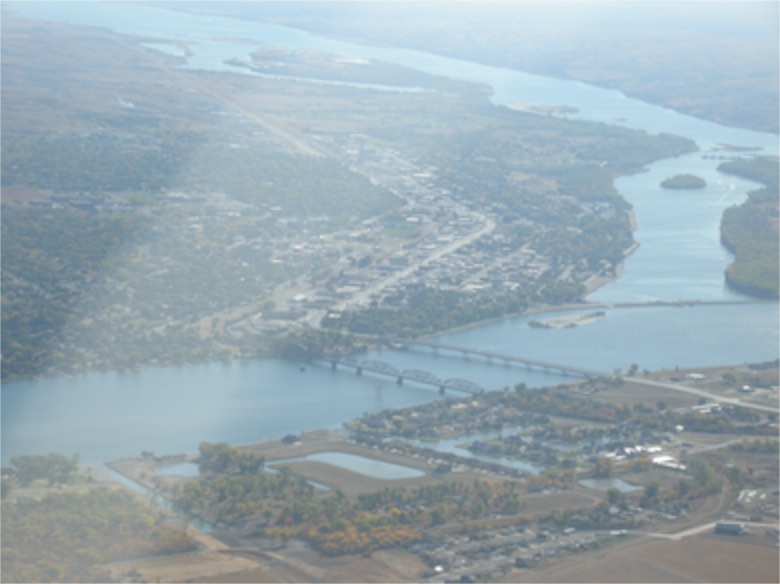
There is a big difference between fantasy and reality. The history of aviation is quite different from what I expected. I’ve don a bit of flying as an adult, but in general private aviation has been beyond my means. Flying safely simply requires a bigger investment of time and money than I am willing to make. Still, I am an “airport bum.” I enjoy hanging around airports, looking at the planes, talking with the pilots and occasionally getting a ride.
My level of participation in aviation has been my choice, really. I chose a vocation that isn’t at the top of the pay scales and I find a life of service to be more meaningful for me than a life invested in the pursuit of income and the acquisition of property. It has been my choice not to own an airplane and it would be possible for me to be involved in an airplane if I rearranged my priorities and made different decisions.
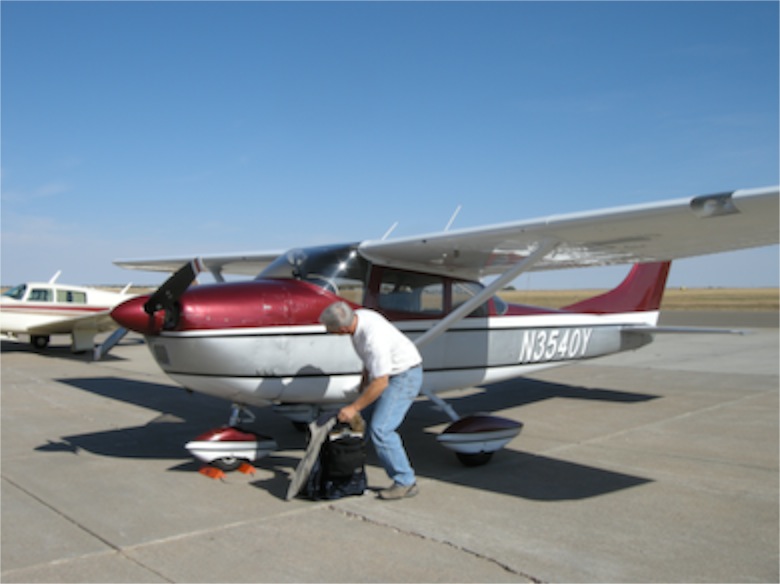
Yesterday, we had a meeting in Pierre and one of the members of our church who is a pilot offered to fly us up for the meeting. Of course I jumped at the opportunity and thoroughly enjoyed the flight. It did save me some time because Rob did all of the work of getting the airplane ready and putting it away after the trip, so I just went out to the airport, flew up, attended the meeting, and came home. It probably saved an hour overall to travel in that manner. It was a joy.
Our trip was in Rob’s beautiful and immaculately maintained Cessna 182. It is a very comfortable four-passenger craft. It is typical for a private airplane. It is nearly 50 years old. Rob and I were only 10 years old when that airplane was new. Parked on the ramp, it doesn’t stand out like some carefully preserved classic. A 1963 model car with a fresh paint job and a new interior would definitely attract attention. You don’t see that kind of car every day. That kind of airplane is normal at airports all around the country.
Cessna still makes the 182. The same basic design that they first started manufacturing in the 1950’s is still being produced by their factory. The price of a new C182, however, can top $450,000. That makes it beyond the reach of even quite wealthy flyers. For a lot less money, it is possible to stick with an older model, upgrade it and maintain it in such a way that it is safe and comfortable to fly.
It isn’t quite fair to say that the technology hasn’t changed in half a century. The basic shape and construction of the airplane is the same. The engines are virtually the same. But what has changed is the electronics and radios. Navigation and communications systems are vastly different and much more reliable than what was common in the 1950’s and 1960’s. Computers are a part of aviation these days, powering everything from satellite navigation receivers to sophisticated engine monitors. The instrument of a factory-new C182 looks a lot different than the one in Rob’s airplane, and the center of Rob’s panel, where the radios are, has been replaced with all new equipment since it came from the factory.

The story of my life is different in part because the times are different. The challenge that my father felt as he went about growing a successful small business has been different for me. I entered my vocation at the beginning of a decline in mainline Protestantism. My challenge has been to grow churches in a culture where churches are on decline. It has been no less of a challenge and the sense of meaning from my work has been deep indeed. But there are some days when I don’t feel like I am on the cutting edge of anything. Some days I feel like my job is to preserve memories of the past as much as inspire innovations for the future.
But when I look back, it seems like there have been more innovations in the ministry and in religious life than there have been in general aviation in the past half of a century. We are doing new things in new ways every day in the church. The emerging church is vastly different from the existing church. The future is exciting and open.
I still look to the sky even though I’m not an active pilot.
Copyright © 2012 by Ted Huffman. I wrote this. If you want to copy it, please ask for permission. There is a contact me button at the bottom of this page. If you want to share my blog a friend, please direct your friend to my web site.
Back and Forth
The forecast calls for a chance of rain tomorrow and for descending temperatures throughout the week. We have a chance of snow Friday, though it hardly seems possible as we enjoy the beautiful weather. That is one of the great features of the hills. The weather can surprise you. Sudden changes in temperature and in other weather conditions are a part of living here. There have been records set in the hills for the most rapid change in temperature and for the largest variation in temperature in two points only ten miles apart.
I like it that way. The element of surprise adds a certain flavor to life here.
The forecast does, however, remind me of several chores around the place that need to be completed before the snow flies. I’ll be scrambling to get things done in the edges around what already is shaping up to be a busy week. In fact, October is shaping up to be a very busy month around the church. We’ve got a lot of activities without many breaks.
We made two short visits yesterday to a friend and member of the church who is nearing the end of this life’s journey. She has had a long and meaningful life. We have watched her decline and knew that this time was coming, but there is still a sense of sadness in sitting at her bedside now that she is not able to talk. We know that she can hear and she opens her eyes when we talk, so we have shared stories and scripture, prayers and memories.
Life has its seasons. We wouldn’t want it any other way. Still, they catch you by surprise, even when they flow in an orderly and meaningful fashion.
We have been praying for precipitation. We can’t complain about snow. We have been praying for an end to suffering. We can’t complain about the transition from this life to what is next.
In Corinthians, Paul asks, “O death, where is your victory? O death, where is your sting?” Anyone who knows the story of our friend’s life knows that it is a story of the triumph of life, of conquering odds, of love embodied, of commitment that brings forth futures. Even as we sat in the quiet room at the care center, we were deeply aware of sign after sign of God’s good gift of life: the pictures of family, the care of the staff, one another drawn together, and the gentle spirit that lingers briefly just to gift us with her presence. This is no tragedy. It is a triumph of the spirit.
For some reason, I have been thinking about writing a memoir lately. I don’t suspect that I will start anytime soon. I have always considered the writing of memoirs to be a task for retirement, though I know of many who have written such documents at younger ages. In fact there are several noted memoirists who wrote multiple memoirs in their forties and fifties. Still there are plenty of things that call me forward enough to make looking backward a bit inappropriate at the moment.
I suspect that the time of ending the educational consultants program last week put me in a bit of a nostalgic mood. I have so many great memories of the program and the colleagues with whom I worked and there is a bit of a sense that the institutional memory will be short on educational ministries in the United Church of Christ. There are plenty of visionary young leaders who will help the church discover new opportunities of ministry, but few of them remember the struggles and hard work we invested in our time. That may be good, but one can’t help but fear some repeated mistakes and a slowing of forward progress while new people learn age-old lessons.
At any rate, it isn’t time to start writing a memoir at present. In the first place, I am too busy. This is an exciting season to be in the midst of our congregation. We are engaged in a new budget process. We are experiencing significant growth in membership and in giving. There are emerging ministries bubbling up all over and new projects starting in many different venues.
Another good reason to avoid writing a memoir, or at least to avoid publishing such a document, is that despite what we think, our memory is rarely accurate. A remembered tale can be entertaining and a good read, but there is almost always a different perspective on the events of the past. And, as many memoirists know, that different perspective is likely to come from a beloved family member. Memoirs may tell a family story to the world, but they rarely bring the writers into favor with the rest of the family. It is just too easy to misrepresent an incident or to portray a family member in a less than flattering manner.
I know that when I am with my siblings, we have different takes on our common past. We remember similar incidents in different ways. There are incidents that one remembers that others do not. I once remarked that I need to be reminded that my brother and I grew up in the same house with the same parents. Sometimes when he gets to talking about the past I don’t recognize his stories. I don’t particularly want him to write a memoir. I’m sure he feels the same about me.
So today, weather permitting, I’m off to a meeting in Pierre at the beginning of what will prove to be a very busy week. The weather will do what it will. We will part for this life from a friend. Life will go on. Looking forward seems to be a good way to think.
Copyright © 2012 by Ted Huffman. I wrote this. If you want to copy it, please ask for permission. There is a contact me button at the bottom of this page. If you want to share my blog a friend, please direct your friend to my web site.
Searching for a Dragon
Many designs were named after animals, but that came only after a series named after insects. There were a lot of designs named moth. After the original moth, there was a Gipsy Moth and a Moth Major, a Tiger Moth and a Hawk Moth. Puss Moth, Swallow Moth, Leopard Moth and Hornet Moth were all in the series. And then there was the Mosquito, considered to be the most versatile of all World War II fighters.
Bush pilots know the mammals. The Beaver is perhaps the most famous of all bush planes. There are plenty of 50-year-old Beavers working today. Viking air is a company based on converting Beavers to turboprop engines so they can keep working for many more decades. The company also produced the Otter, and Caribou.
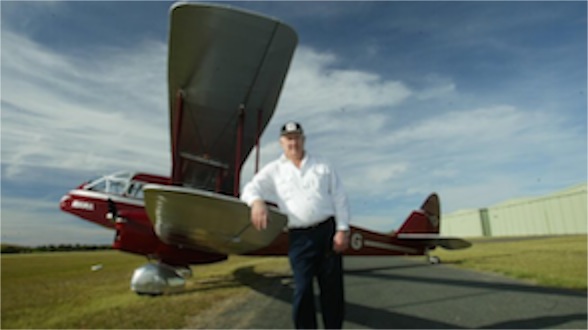
All in all over 200 dragons were built with a couple of variants in engines. They saw airline service around the globe and served as military transports for at least 15 countries . The dragon was a popular airplane that figured deeply in the founding of Qantas Airlines in Australia.
So my attention is directed toward Australia where a beautiful restored Dragon went missing today. Thick clouds are hampering the search. The airplane was outfitted with an emergency locater transmitter, which did go off, but has subsequently ceased to operate. It is feared that the plane has crashed. It would have to have ceased flying because it would have run out of fuel. It is somewhere along the rugged Queensland Sunshine Coast. The plane was bound to its home base at Cabociture from an airshow in Monto. Pilot was Des Porter. When he was 11 years old Porter was the sole survivor of a plane crash that killed his father and older brother. The airplane in that accident was a DH84 Dragon, flown by Poter’s father.
The missing plane is a beautifully-restored dragon painted red with white trim named Riama. It is a favorite of air shows around Australia.
The community of pilots and fans of antique aircraft is large and extensive. Accidents are not unknown at air shows, but rarely do they involve the antique aircraft. The vintage planes are carefully operated and, for the most part flown only in the best of weather. But accidents do occur.
There is a debate about flying antique aircraft. Some airplanes are considered to be too unique in their design and too unstable for regular flight. They are consigned to museums where they can be seen. The Wright Flyer hangs in the Smithsonian Air and Space Museum. Charles Lindberg’s Spirit of St. Louis is there also. Replicas have been made of these planes, but even the replicas are mostly in museums these days.
But the DH84 Dragon was different. It was made for rugged service. It was known for its excellent flying qualities and reliability. There were Dragons that gave over 50 years of active service as working airplanes. This year marks the 80th anniversary of the design, however, so the only remaining examples are show planes, carefully restored and maintained.
In a best-case scenario, Des Porter was able to walk away from an off-airport landing, the damage to the plane is minimal and both will live to fly another day. In a worst-case scenario, there is deep irony that Porter was flying the same make and model of airplane that took the life of his father and brother 58 years ago.
Australian authorities are searching with the best equipment available. A helicopter and a fixed-wing aircraft equipped with infrared search devices have arrived to assist in the search. It is 9:30 at night in Australia as I writ this, so no news is expected before tomorrow Australia time. We watch and we wait. It is a nervous time.
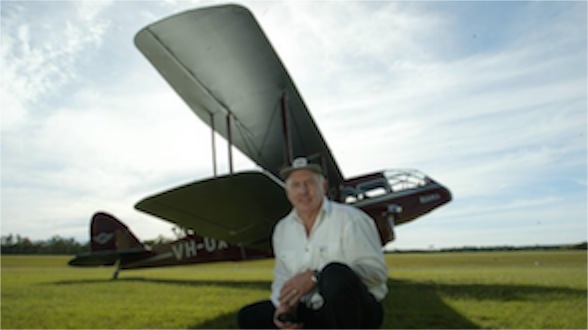
The world is waiting for news of the search between Kingaroy and Maleny. Pilots and airplane fans are hoping and praying. Even if the plane is lost. Even if the crash resulted in the death of Des Porter, there will be plenty who think the joys of flying antique airplanes outweigh the risks.